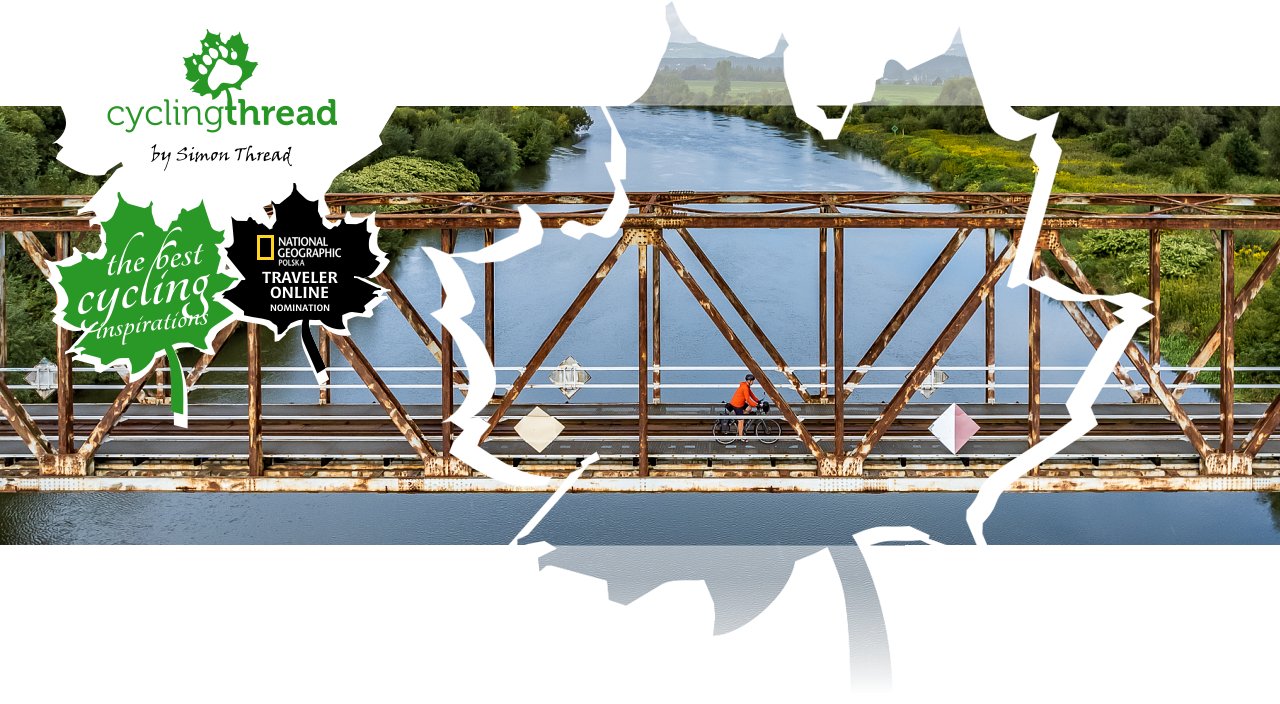
Vistula Cycling Route and more. A weekend on two wheels in Western Malopolska
The Vistula Cycling Route is the first cycle route constructed as part of the Velo Małopolska project, aimed at developing modern cycling routes. Established in 2017, the Vistula Cycling Route has been gaining popularity among both residents of Kraków and the broader Malopolska region (called Lesser Poland sometimes), as well as among tourists exploring Poland on two wheels. Seven years after my initial visit, I returned to the western section of the Vistula Cycling Route to explore how a one-day segment from Oświęcim to Kraków could be extended into a longer, weekend cycling adventure in Malopolska.
See also the Vistula Cycling Route in Pomorskie.
Route on the map
GPX file (GPS track): cyclingthread.com-malopolska-2023.gpx
Vistula Cycling Route - table of contents
- The unique cycling route along the Vistula
- The Vistula meets the Carp Valley and Łączany-Skawina Canal
- Convenient travel to Malopolska by train
- Luxurious pragas made in Oświęcim
- Gentle curves of the Vistula Cycling Route
- Mętków - the unknown cyclists' village
- In Wygiełzów, a castle and an ethnographic park await
- Cyclist-friendly places in Malopolska
- Carp Valley for sustainable regional development
- Cycling through the Carp Valley
- The most attractive section of the Carp Valley Route
- Visit to the Beskid Ecomuseum
- Zator awaits the renovation of the Potocki Castle
- Great atmosphere during the Małopolska Tour
- Velo Skawa coming soon along the embankments
- On a Worldtraveller across Malopolska and India
- Okleśna bridge is not part of the Vistula Cycling Route
- Castles in Babice, Zator and Spytkowice
- Further kilometers on a cycling journey through Malopolska
- A former granary transformed into a library
- Several kilometers along the Łączany Canal
- Weekend on the Vistula Cycling Route
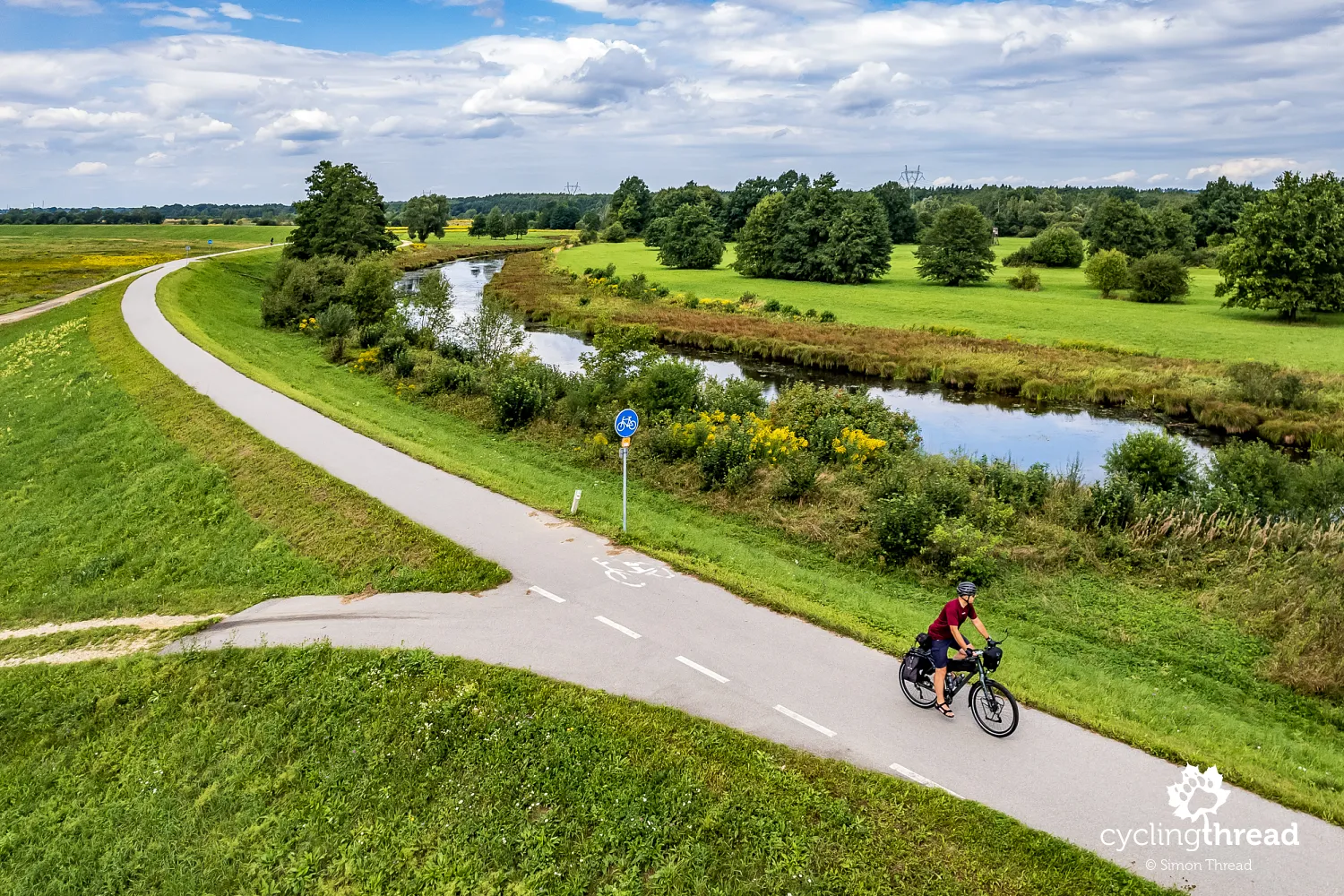
The unique cycling route along the Vistula
Just as a reminder - the Vistula Cycling Route in Malopolska spans 230 kilometers, stretching from Oświęcim through Kraków to Szczucin, a town on the border of the Malopolska and Świętokrzyskie regions. According to the official Visit Małopolska website, 210 kilometers of this route are complete, mostly laid out on comfortable and safe bike paths built on the Vistula’s flood embankments. It's worth mentioning that none of the other provinces along the Vistula in southern Poland have developed their own infrastructure for cycling tourists. Neither Mazovia, Silesia, Świętokrzyskie nor Lubelskie regions have established a safe, comfortable cycling route along the Vistula. The only other region in Poland that has undertaken a similar initiative to Malopolska is Pomorskie. However, the cycling paths along the Vistula River in Pomorskie are shorter and do not cover the entire stretch. Both of these Vistula routes are so well-developed that I count them among the top bicycle routes in Poland.
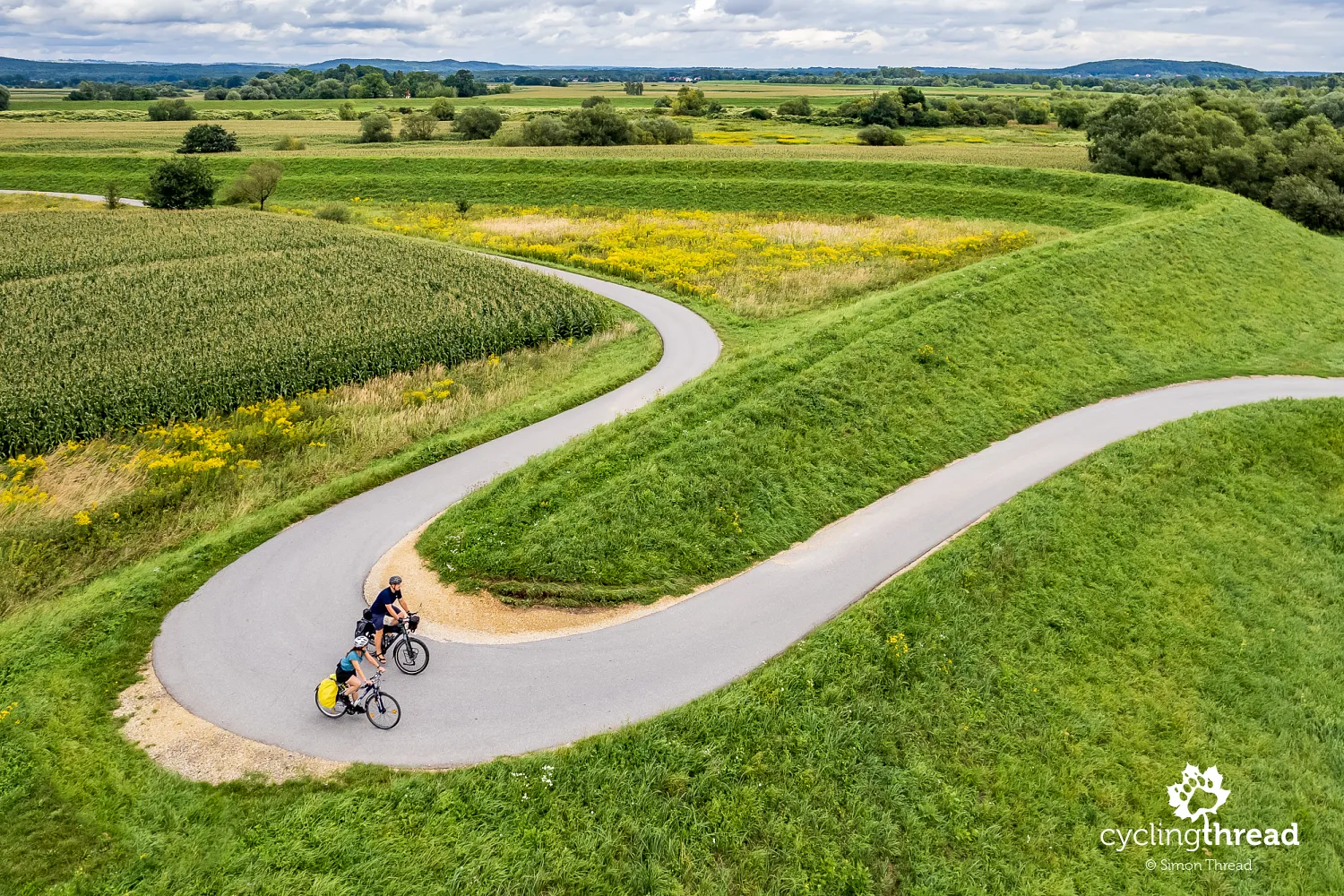
The Vistula meets the Carp Valley and Łączany-Skawina Canal
What some consider a major advantage of long-distance, riverside cycling routes, others see as a drawback. The Vistula Cycling Route in Malopolska - apart from around Kraków and its vicinity - bypasses major urban areas, covering many kilometers away from civilization. Some cyclists revel in the contact with the natural surroundings and the tranquility around the route, while others miss attractions and a greater variety of landscapes. This was one of the reasons for my trip - to transform a rather swift, one-day stretch of the Vistula Cycling Route into a more diversified, weekend-long stay in western Malopolska. I divided the two-day route between the Vistula with its cycling route, Malopolska’s Carp Valley with its circular cycling route, and the Łączany Canal (also known as the Łączany-Skawina Canal) with its newly built bike path.
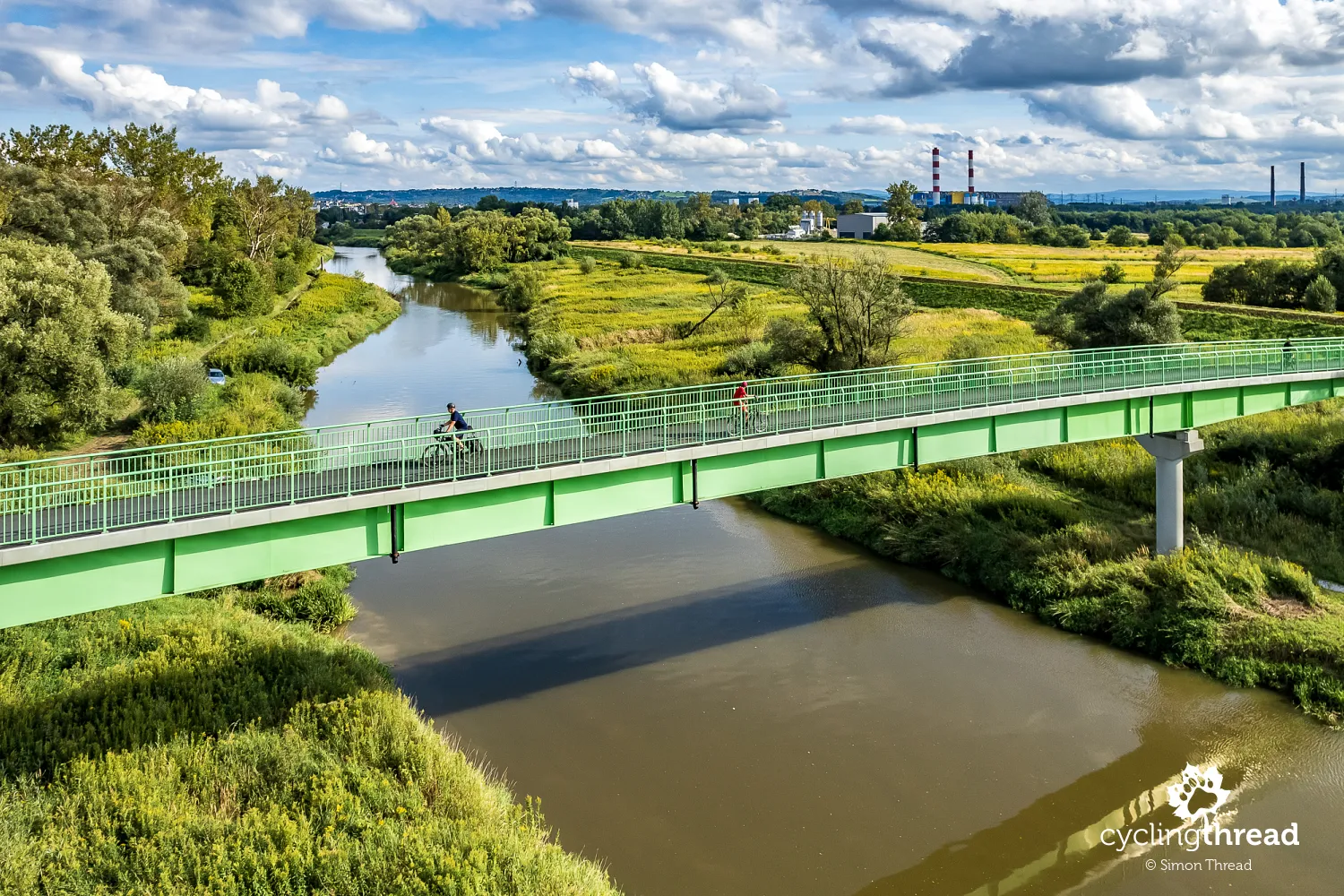
Convenient travel to Malopolska by train
The best starting point for such a cycling weekend in western Malopolska is Oświęcim. Direct regional trains from Katowice or Kraków will get you there in just an hour. Getting back home from Kraków is also hassle-free - both long-distance and regional trains offer limited bike spots, typically restricting them to 4 or 6. Since that’s not particularly many, I encourage booking your tickets in advance. And if you decide to drive to Malopolska, you'll certainly find a place to leave your car in Kraków. However, remember that trains are the most environmentally friendly travel option, usually the cheapest, and they also provide a chance to rest during the journey, unlike driving.
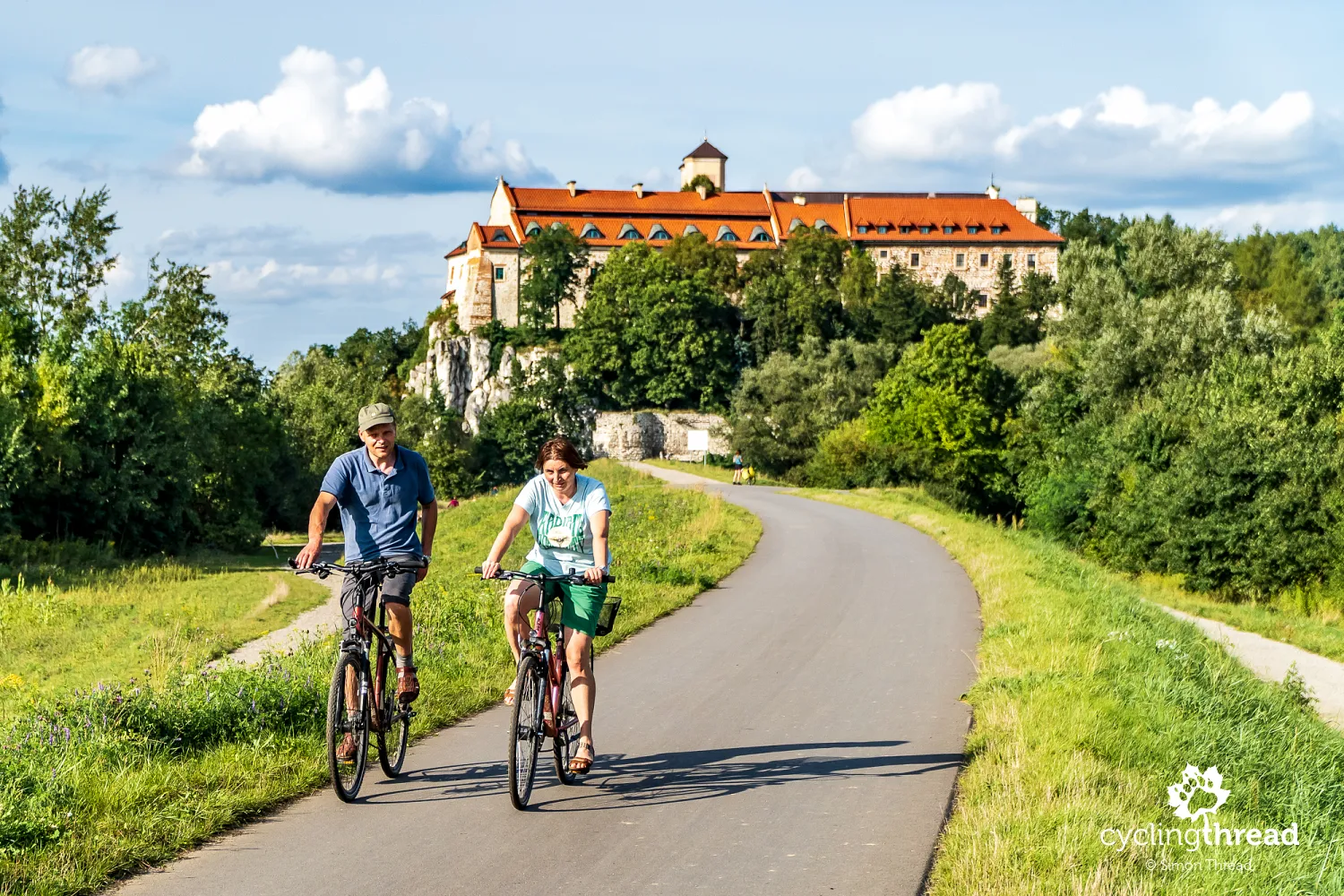
Luxurious pragas made in Oświęcim
Oświęcim in Poland is still primarily associated with the German Nazi concentration camp. While the significance of this site in the history of Poland and the world is undeniable, I always like to remind that Oświęcim also has a pleasant city center across the Soła River. Within a small area, you can see remnants of a Piast castle with a castle museum, the market square with a town hall and another branch of the Oświęcim museum, as well as a surviving synagogue with yet another museum - the Jewish Museum. A unique exhibit in the city museum is a vintage Oświęcim-Praga car. Few visitors know that these beautiful cars were manufactured here in the 1930s under license from a Czech automotive company, with one of their users being Jan Kiepura. Meanwhile, the former synagogue welcomes visitors with its preserved wooden interior, featuring the Aron Kodesh (altar cabinet), a bimah, and benches.
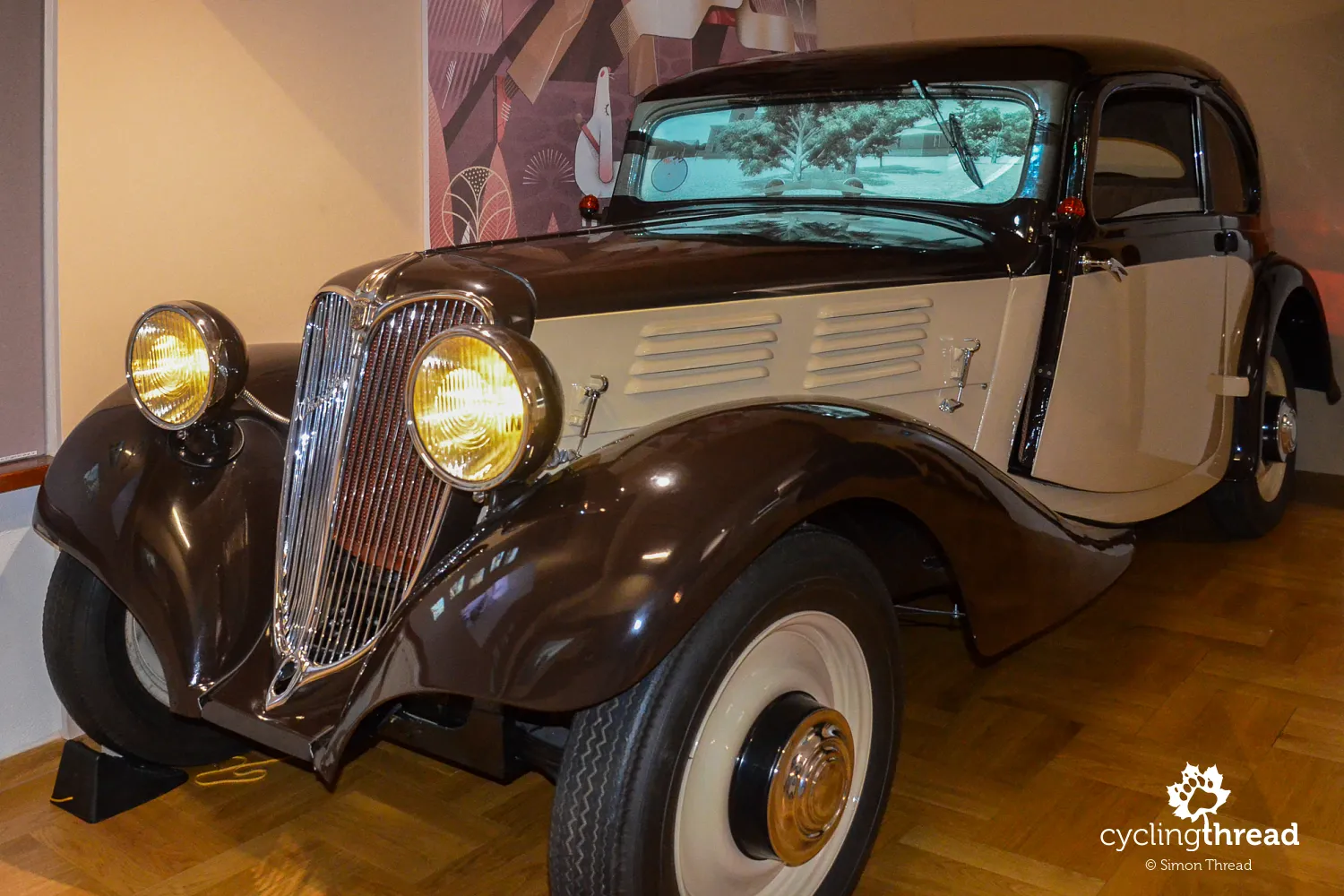
Looking at the main structure of the castle in Oświęcim today, it's best not to see it as a centuries-old monument because it's not even 100 years old. The castle building was constructed at the end of the 1930s, around the same time as the aforementioned Oświęcim pragas. The only part of the castle that remembers all the centuries of its history is the tall tower from the 13th century. The rest of the buildings either burned down, were destroyed (including by Tartars and Swedes), or collapsed into the waters of the Soła, which has been undermining the castle hill for centuries. In the history of the Oświęcim castle, I found another interesting note that I love to "cross" with our various cycling trips. In 1574, Henryk Walezy, the French King of Poland, stopped at the castle in Oświęcim while fleeing back to France. And it was about him and the custom of eating with a fork, which he brought back from Poland to France, that our guide at the Blois castle told us when we were touring the castles of the Loire Valley.
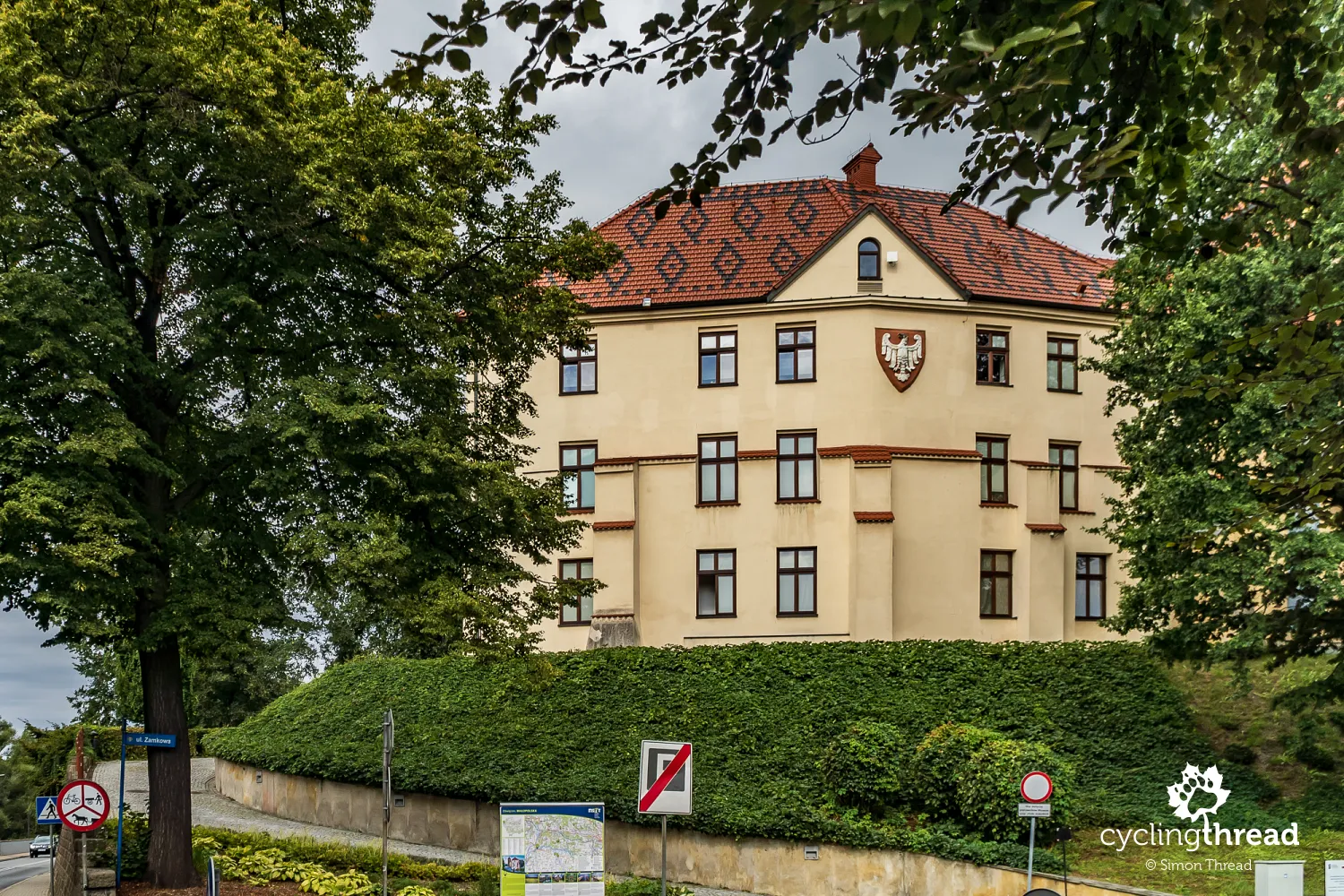
Gentle curves of the Vistula Cycling Route
Just a few minutes' ride from the center of Oświęcim takes you to the Vistula Cycling Route. Crossing the bridge over the Vistula, turn right, and vast expanses of the Vistula Valley unfold before you, with an asphalt bike path slicing through atop the tall flood embankments. Here, the Vistula Cycling Route follows wide, gentle curves along the riverbank, providing a perfect backdrop for a family cycling trip. The lengthy kilometers of the route are safe and comfortable, with the only potential challenge being the wind blowing in the opposite direction - it's worth checking the weather forecast before you set out and possibly reversing your direction of travel. It’s also good to respect the seemingly empty surroundings - it was here on the embankment of the Vistula Cycling Route that I encountered a European hamster seven years ago.
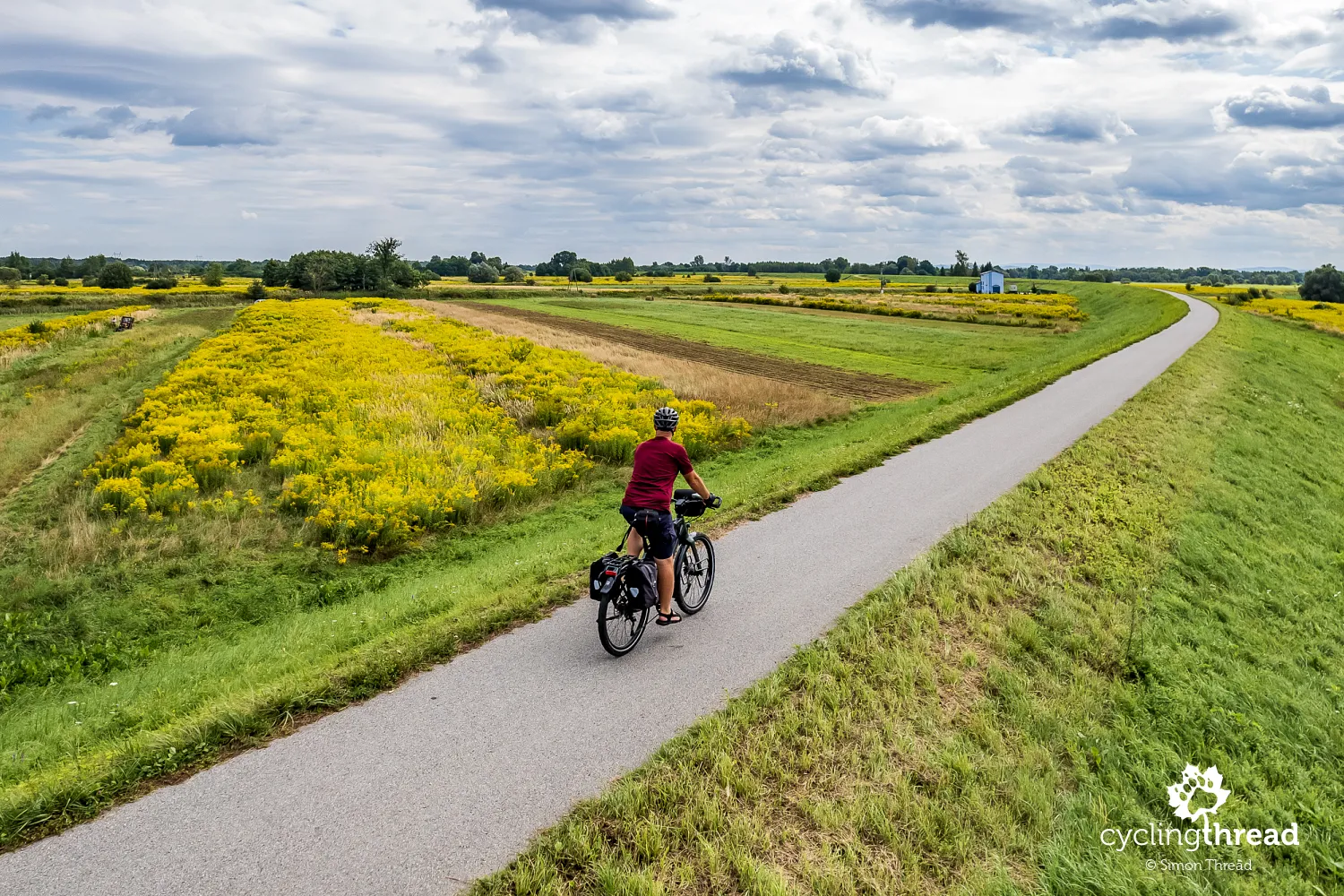
Mętków - the unknown cyclists' village
As planned, I didn't stick to the Vistula Cycling Route for its entire length. I turned off at Mętków and headed straight towards Wygiełzów. In Mętków itself, I paused briefly at the cycling signs in the center of the village - it turns out this is a cyclists’ village! I also visited the historic wooden church, part of the Wooden Architecture Route in Malopolska - 50 years ago, it was moved to Mętków from Niegowice near Wieliczka. Interestingly, this was the first workplace of Karol Wojtyła - the future Pope served as a vicar here when the church was still in Niegowice. For those interested in the trails of John Paul II and collecting his "footprints," this may be an intriguing stop.
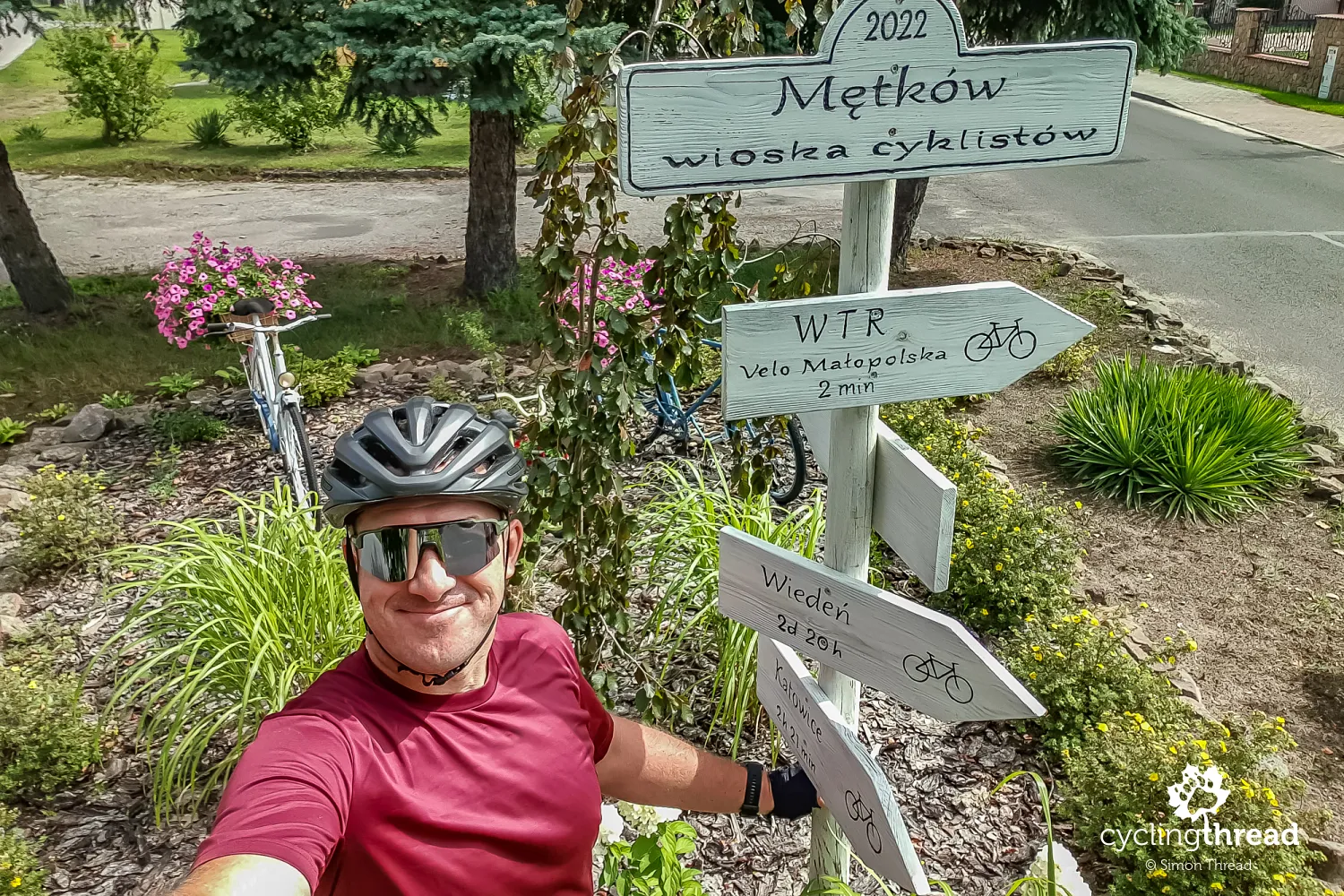
In Wygiełzów, a castle and an ethnographic park await
In Wygiełzów (and just above it), two interesting sites await the tourist, including cyclists. The first is the open-air museum - the Museum of Western Malopolska, operating under this name only since 2023, previously known as the Vistula River Ethnographic Park. The Wygiełzów open-air museum showcases 25 monuments of Malopolska’s wooden architecture, capturing the rural and small-town ambiance of old Malopolska. In addition to traditional rural homesteads, there is also a manor, craft workshops, a church moved from nearby Ryczów, and a section of a small Malopolska town. The pleasant atmosphere is created not only by the richly furnished interiors of rural homes but also by their well-kept surroundings, making a visit to the Museum of Western Malopolska not only an educational exploration but also an aesthetically pleasing one.

Dominating the open-air museum is the imposing silhouette of Lipowiec Castle. It's worth climbing to the top just for the view that extends from the castle tower. The preserved shape of the castle dates back to the 13th century, and although it has been ravaged many times, including during the Swedish Deluge when it was captured by the Swedes, it can be considered to have survived to the present day in quite good, close to original, condition. Lipowiec Castle was part of the famous "Eagles' Nests" system, the furthest outpost in the south-west direction, which served as a fortress guarding the trade route from Silesia to Malopolska. Among the notable figures associated with Lipowiec Castle is not only King John III Sobieski, who stayed here before the Battle of Vienna, but also cavalry captain Witold Pilecki, who spent a night near the castle during his escape from the concentration camp in Oświęcim.
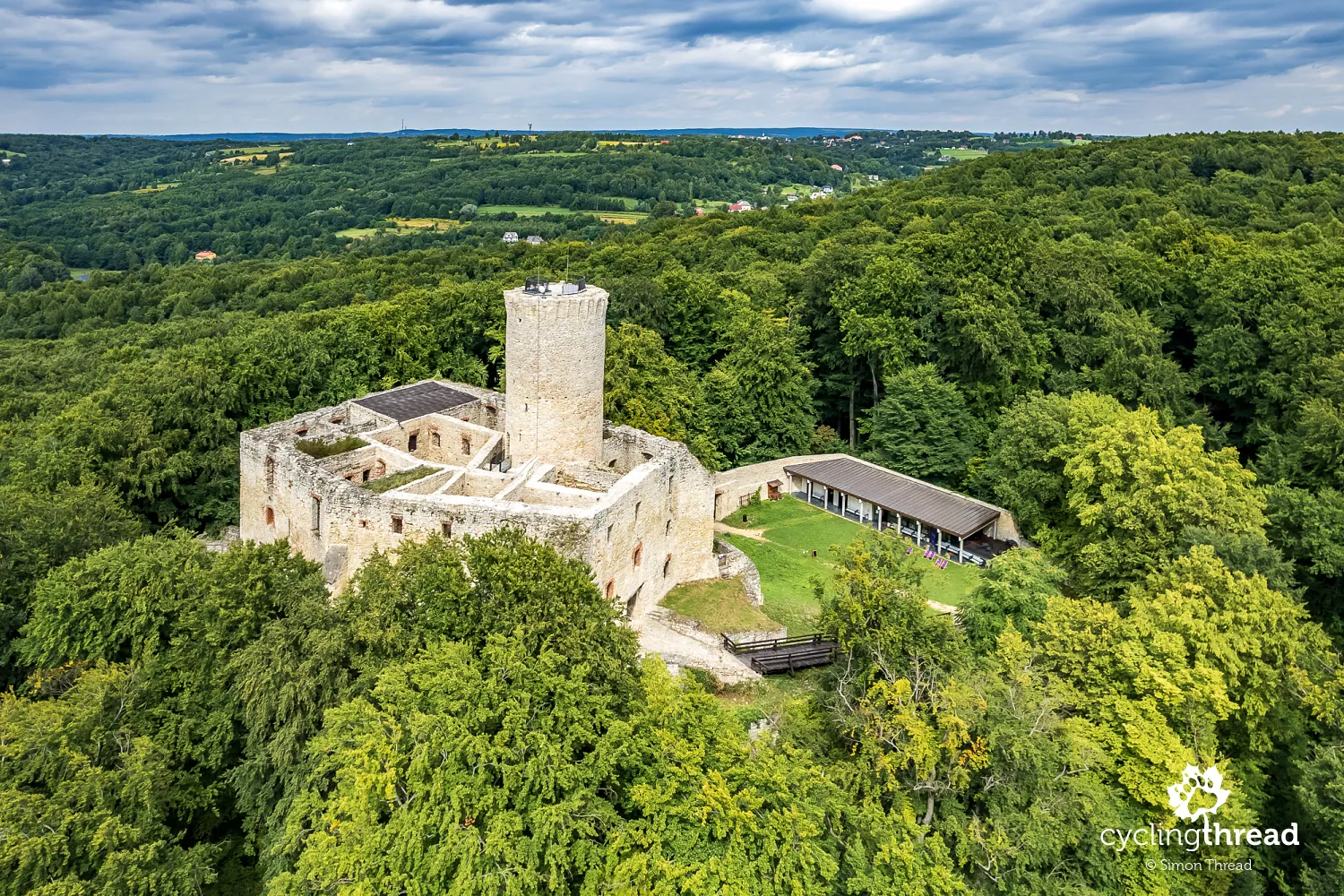
Cyclist-friendly places in Malopolska
In a photo I took under the building housing the ticket office of the open-air museum in Wygiełzów, I spotted a plaque with the MPR logo and information for cyclists, indicating that the open-air museum is listed among Malopolska’s Cyclist-Friendly Places. Currently, about 230 facilities are part of the Malopolska network, with around a hundred being various types of accommodation. So if you're planning a cycling trip to Malopolska and care about safely storing your bikes during overnight stays, it’s worth starting your search on the Cyclist-Friendly Places in Malopolska website. Besides accommodations, you will also find places like the Wygiełzów open-air museum that can provide you with information about the nearest available shops and bicycle services, as well as a set of the most necessary bicycle tools.
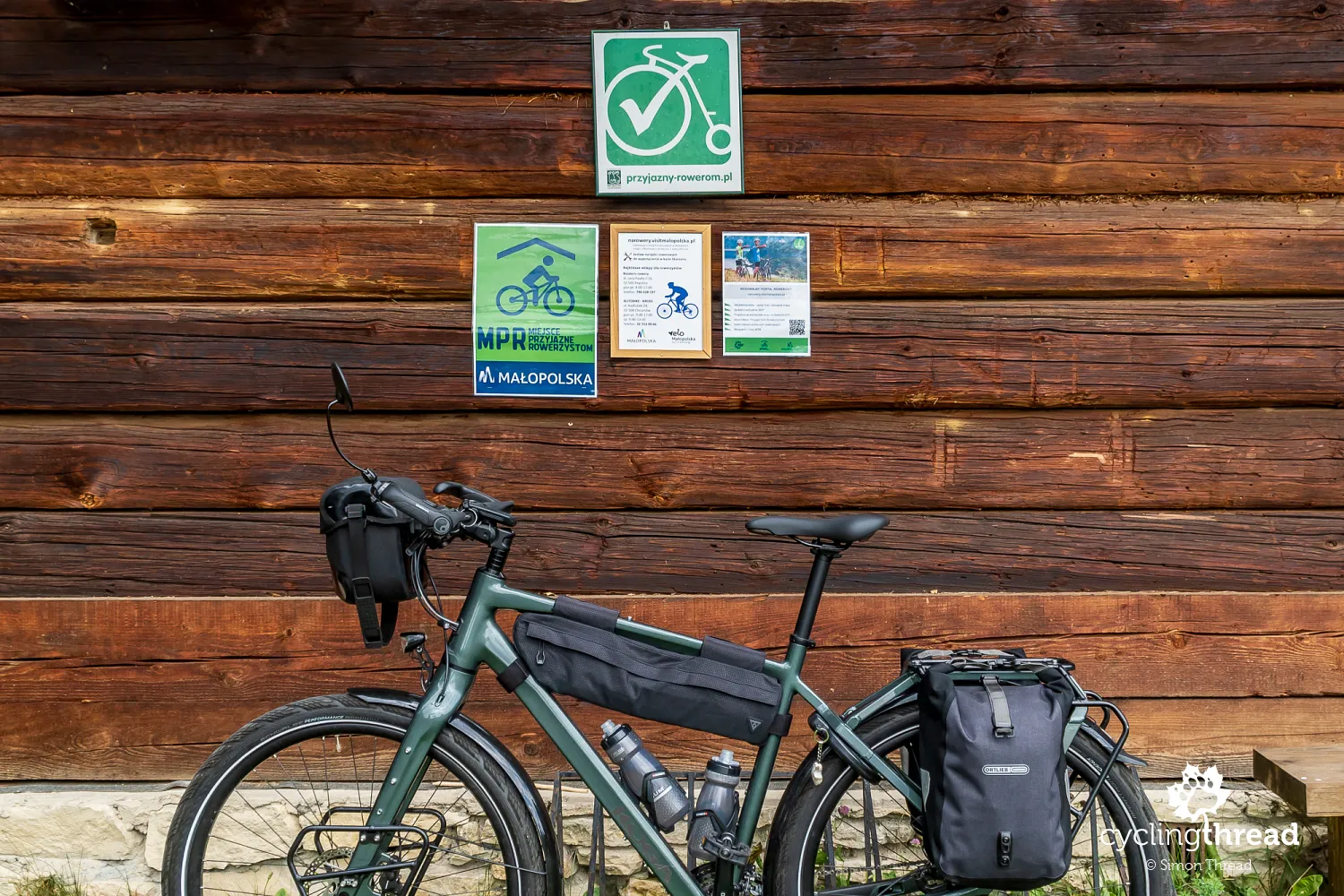
Carp Valley for sustainable regional development
The next destination on my Western Malopolska route was the Carp Valley. This area boasts dozens of fishponds, originating as far back as the times of Bolesław the Wrymouth, dating back to the 12th century. Today, Carp Valley is also an association committed to achieving sustainable development goals in the region and the name of a local brand promoting the area. On its website, Carp Valley lists places that tell the story of local traditions - including the Regional Chamber of the Zator Land and Carp Valley in Zator, and regional chambers in Osiek, Ryczów and Tomice. Visiting at least one of these provides a good insight into the local atmosphere. Unfortunately, the journey from Wygiełzów to Carp Valley is the least pleasant part of the trip, involving a few kilometers along a fairly busy road alongside cars.
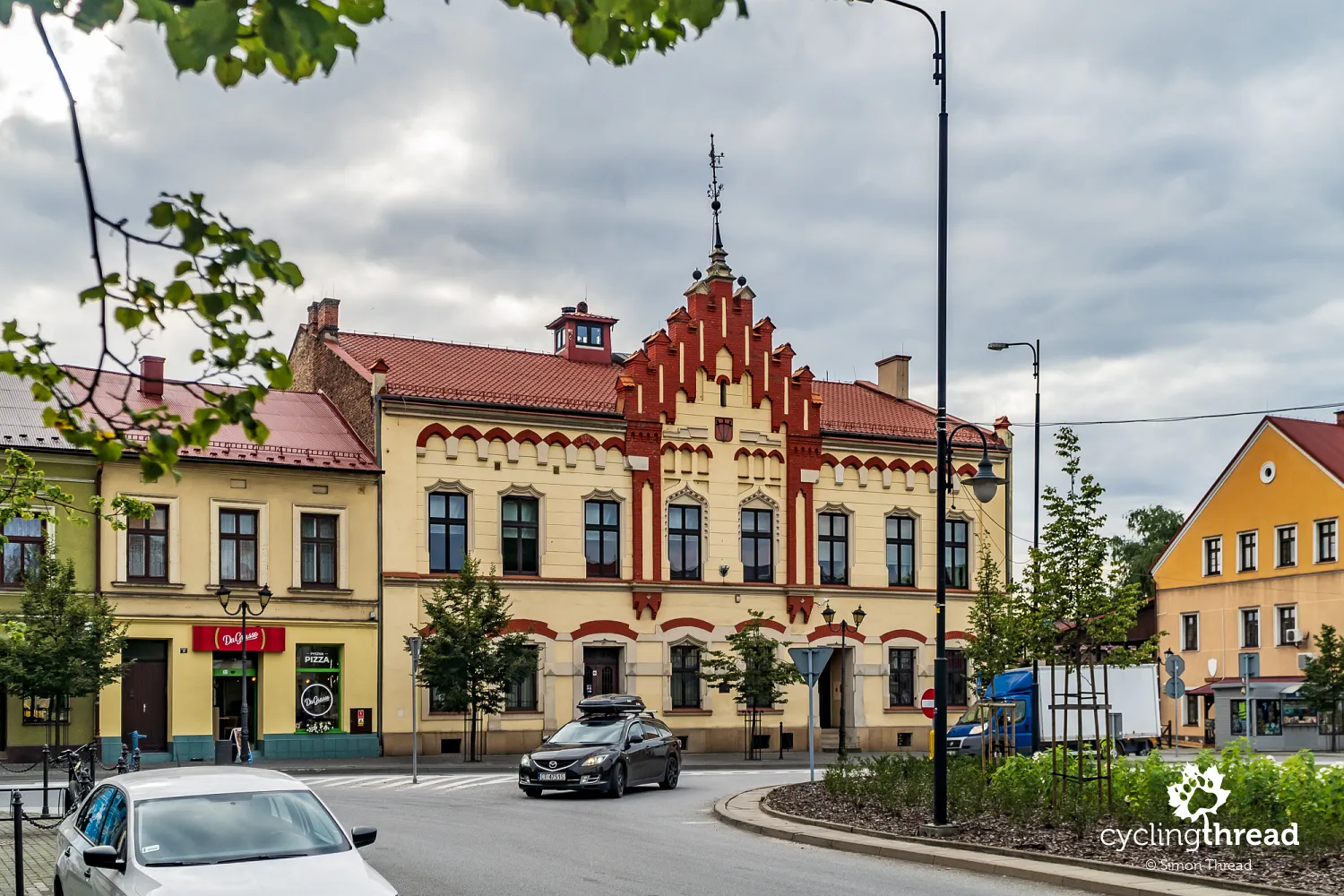
Cycling through the Carp Valley
For a short ride through Carp Valley, I took the Carp Valley Bike Route. This is an 86-kilometer loop, marked on-site, passing through towns such as Zator, Przeciszów, Osiek, Spytkowice and Brzeźnica. Note that this route is in its traditional form, sometimes running along quiet, green embankments between the fishponds of Carp Valley, and at other times along regular roads with traffic. Despite the noticeable high level of development in Carp Valley, there is practically no cycling infrastructure here, forcing cyclists to share roads with cars. This doesn't have to be a deterrent to visiting the area, though in practice, it raises the bar slightly and probably excludes riding my route with a family, particularly with children riding independently on their own bikes.
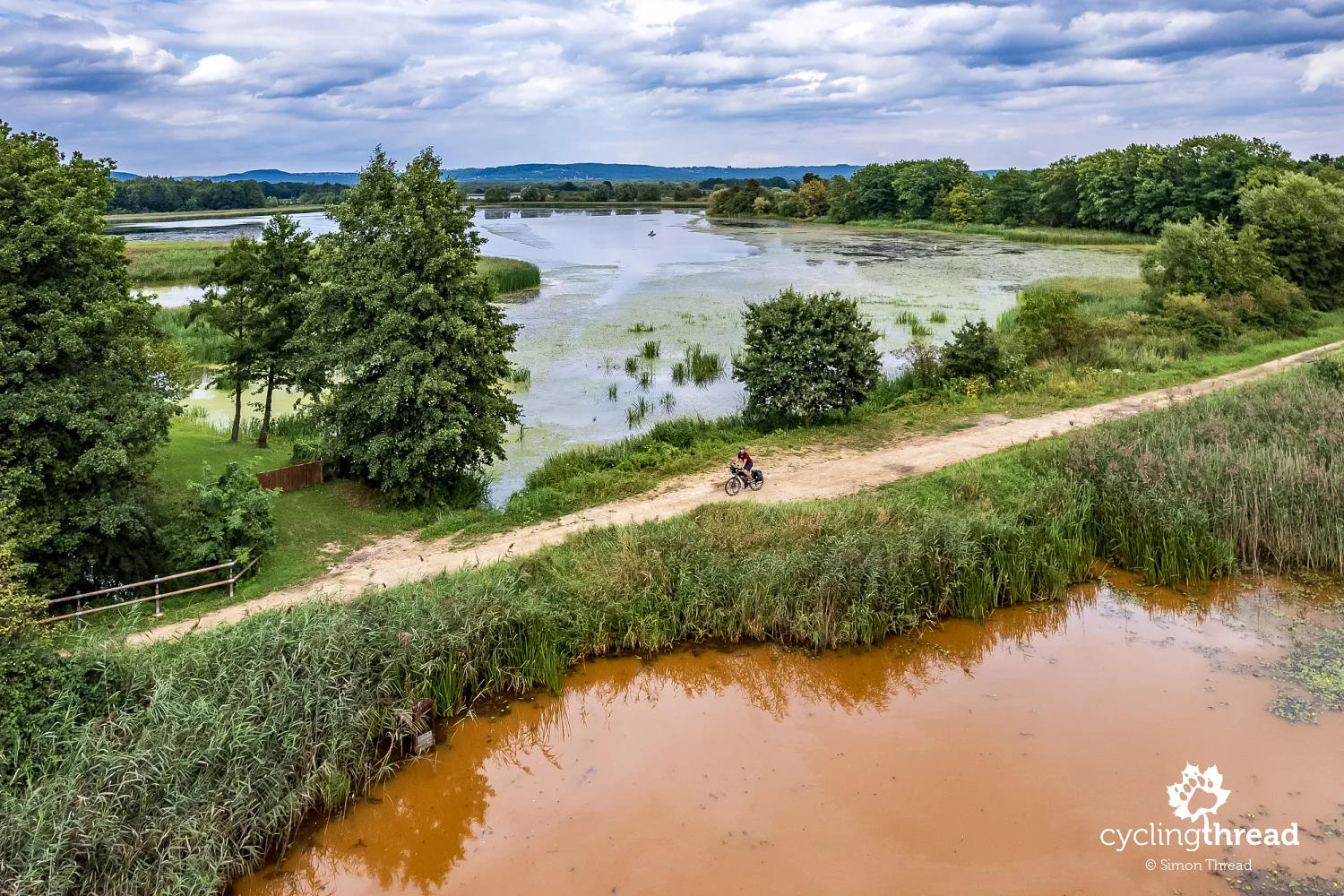
The most attractive section of the Carp Valley Route
Certainly, the most charming section of the Carp Valley Route is a several-kilometer stretch crossing the fishpond complex around Przeręb, a small hamlet surrounded by several fishponds. During rainy periods, it will surely be damp here, and short muddy patches may appear on the path, but it will also be very green and natural. First, a natural path leads through dense clumps of forests and shrubs that grow on the embankments between the ponds, then we ride onto a narrow, quiet asphalt road winding between the ponds. Without a doubt, this is one of the most picturesque places in Carp Valley. A keen eye might spot old signs of the Vistula Cycling Route, which before the Velo Małopolska era, passed through these beautiful surroundings.
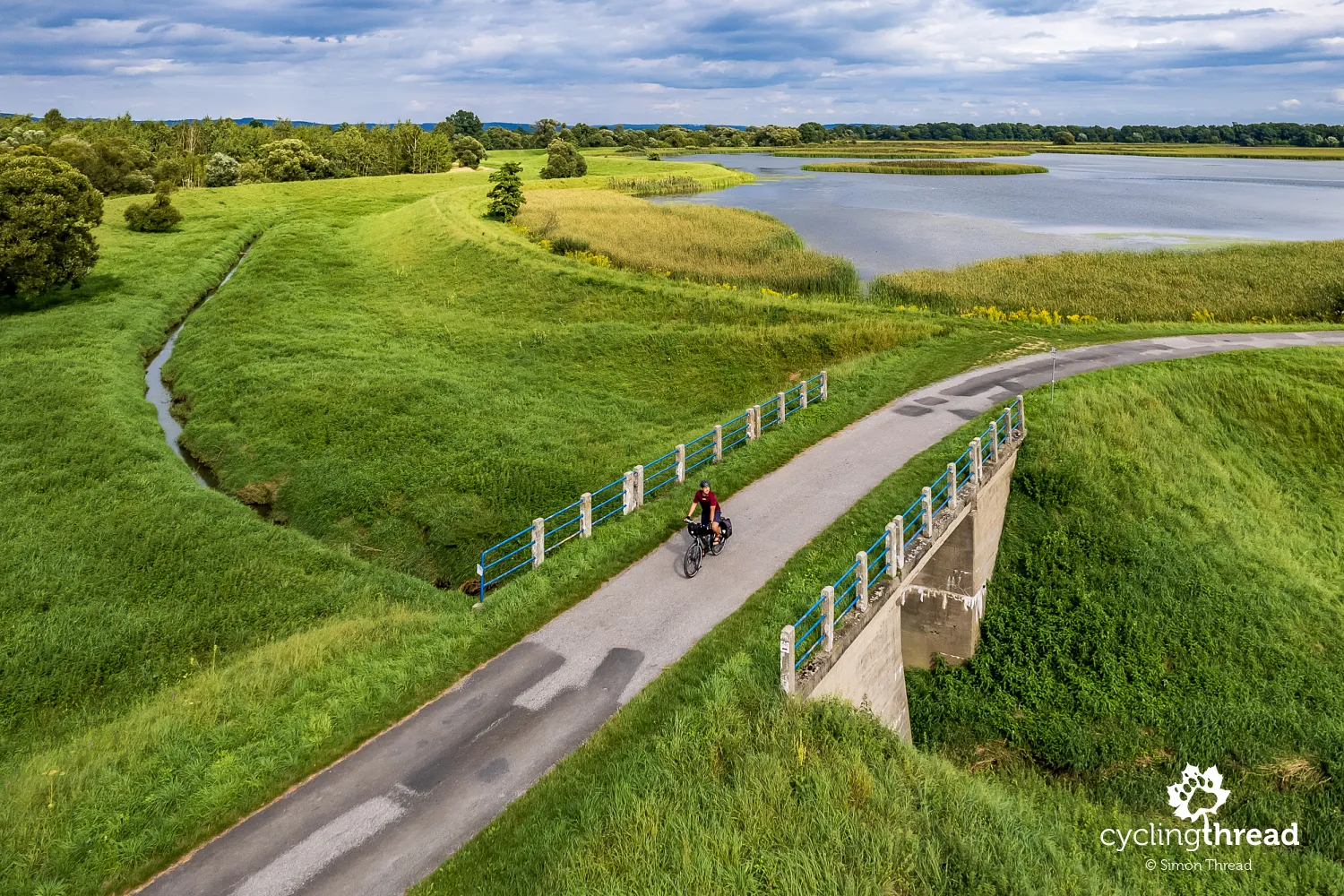
Visit to the Beskid Ecomuseum
The place in Carp Valley that impressed me the most was the wooden Church of St. Nicholas in Polanka Wielka, another site on the Wooden Architecture Route in Malopolska. The interior of the church in Polanka Wielka houses one of the several branches of the Beskid Ecomuseum - a project that presents valuable historic churches of the Bielsko-Biała diocese in a new way, using them as unique exhibition spaces. Entering the 16th-century church in Polanka Wielka, I was surprised by the arrangement of its interior into an atmospheric museum hall, where valuable sacred artifacts are displayed in showcases. This fresh, original approach to presenting historic collections is also a great inspiration for tourists, as the next small tourist challenge might be visiting all the sites that make up the Beskid Ecomuseum.
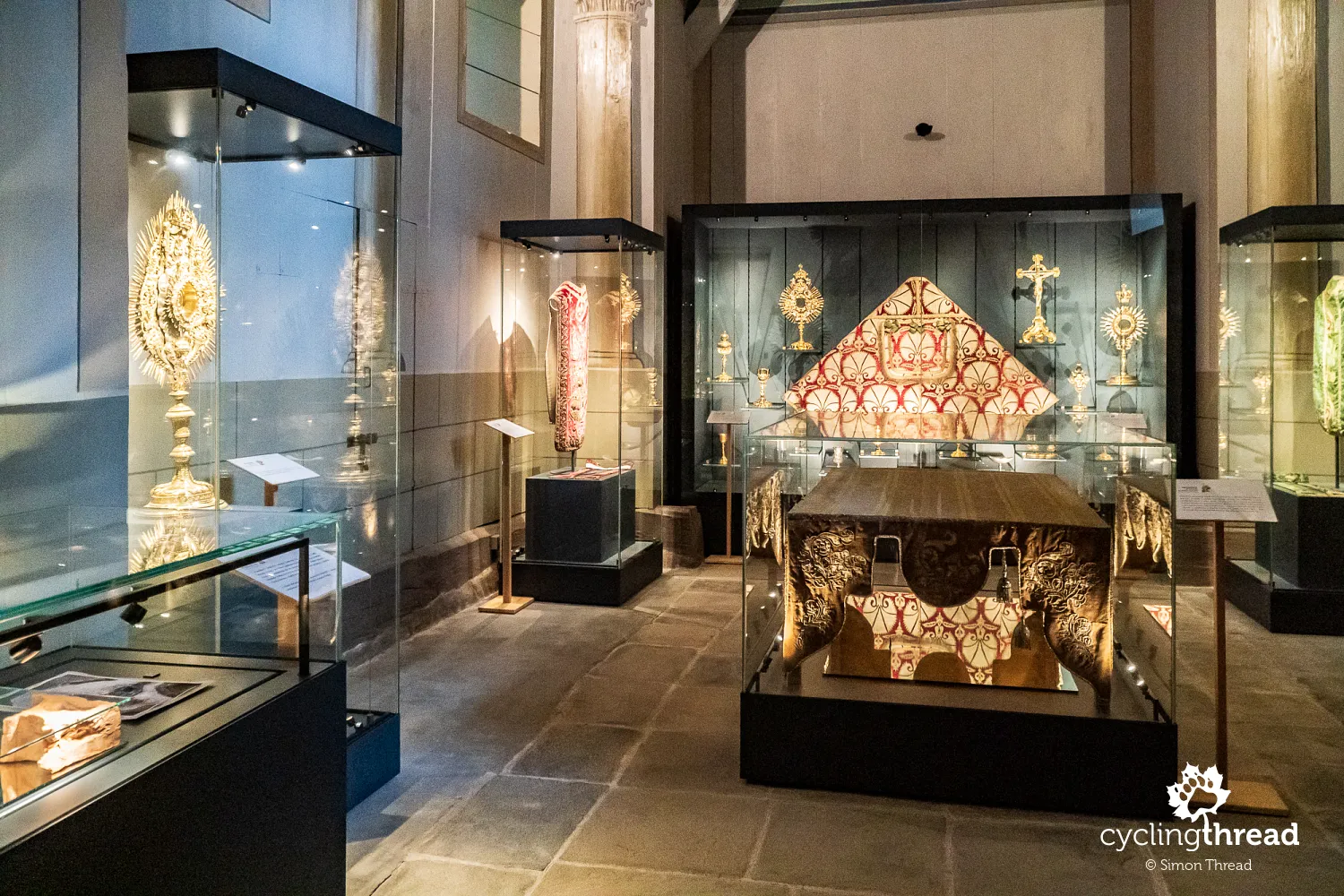
Zator awaits the renovation of the Potocki Castle
The small town of Zator, the central point of Carp Valley, is known in Poland primarily for Energylandia, a huge entertainment center whose tall structures are often visible on the horizon during a trip in Malopolska. The town is an excellent place to stay during our two-day excursion - thanks to Energylandia, it has a fairly rich tourism base, mainly consisting of private "apartments," which in practice are various types of homes arranged for tourist purposes. I stayed in one near the market square in Zator, booking through a popular reservation service. In Zator, it's also worth checking out the construction-reconstruction of the Baroque palace, which in 2013 returned to the hands of the Potocki family. Once the work is completed and the park space around the castle is opened to visitors, the town will gain a wonderful image asset, and tourists yet another interesting place to see.
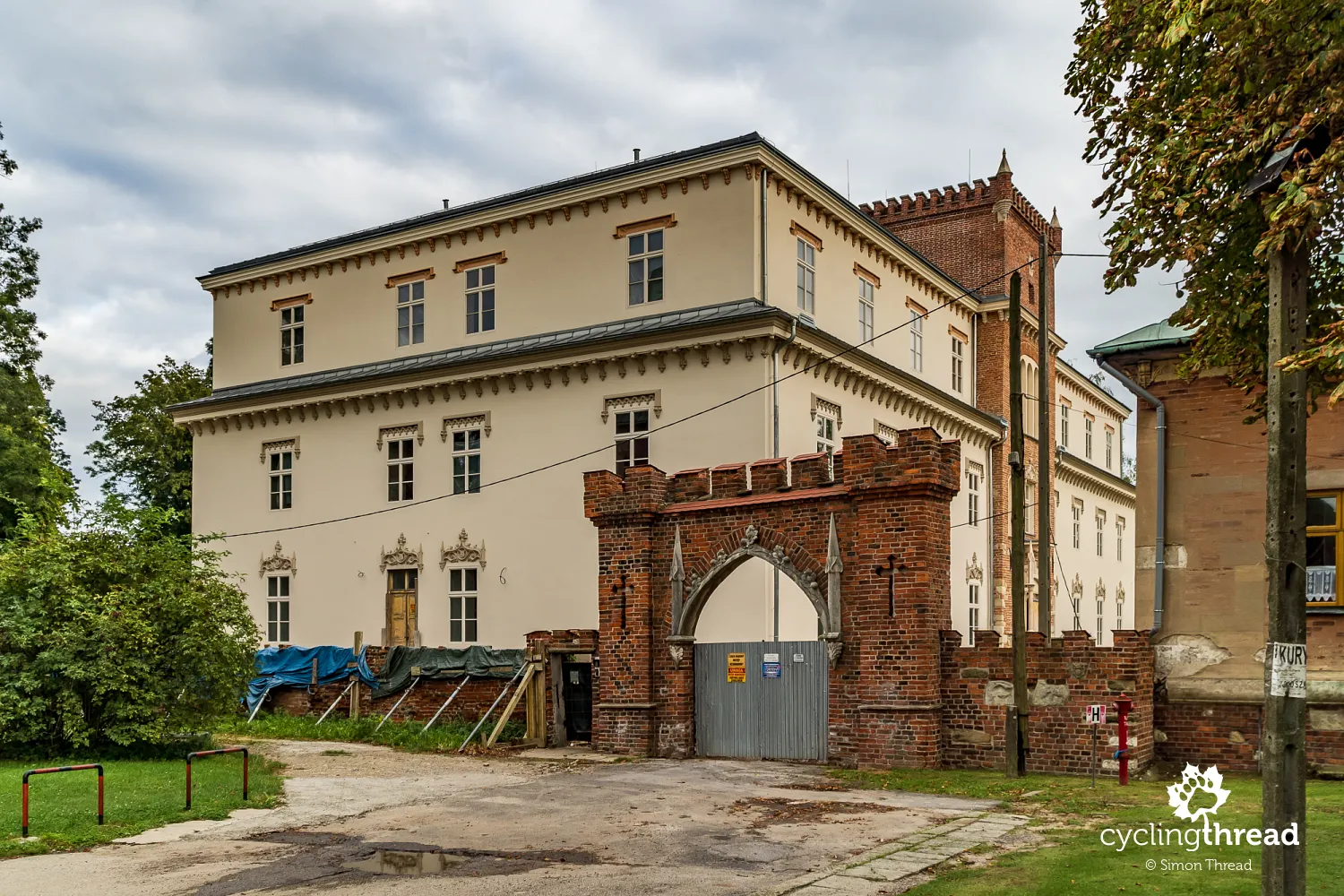
Great atmosphere during the Małopolska Tour
Part of building a cycling atmosphere in Malopolska are the regularly organized recreational events for residents of the region named Małopolska Tour. It so happened that the third edition of Małopolska Tour in 2023 took place in nearby Wadowice, just a few kilometers from Zator, so I took the opportunity and joined the colorful, cycling crowd of Małopolans. There have been several "Tours" in different parts of Malopolska, so they have gathered a considerable number of participants. Many of them take part in all editions of this family event, visiting various corners of the region. Among the regular highlights is always a cycling ride around the area at a chosen distance, thrilling rides by the youngest cyclists on a special route, and an evening concert by a well-known performer. I felt that day in Wadowice, everyone was a cyclist.
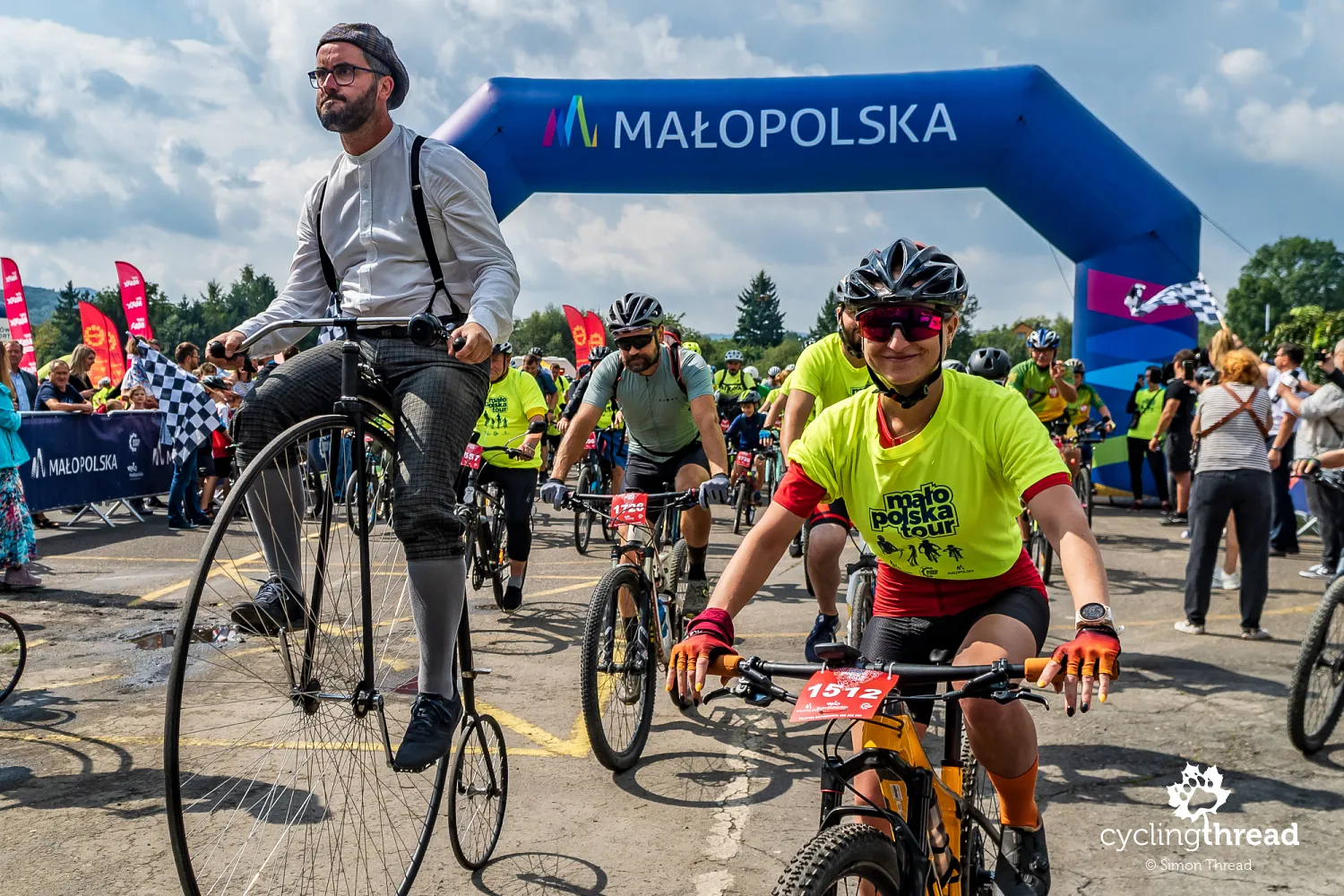
Velo Skawa coming soon along the embankments
Leaving Zator for Kraków, the route leads along a massive flood embankment—not of the Vistula, but of the Skawa River. Currently, it's still just a regular, field road atop a rather high embankment, but in a few months, it will be transformed into a wide, asphalt bike path as part of another Velo Małopolska network route - Velo Skawa. Velo Skawa will start in Sucha Beskidzka and end in Hutki near Olkusz. It will initially run along the waters of Skawa, cross the Vistula, and then visit Alwernia and Trzebinia. This plan is outlined in the Velo Małopolska network project, although the first phase includes completing the segment from Sucha Beskidzka through Wadowice, Zator, and connecting along the Vistula flood embankments with the Łączany Canal. This will be another excellent bike route in the region!
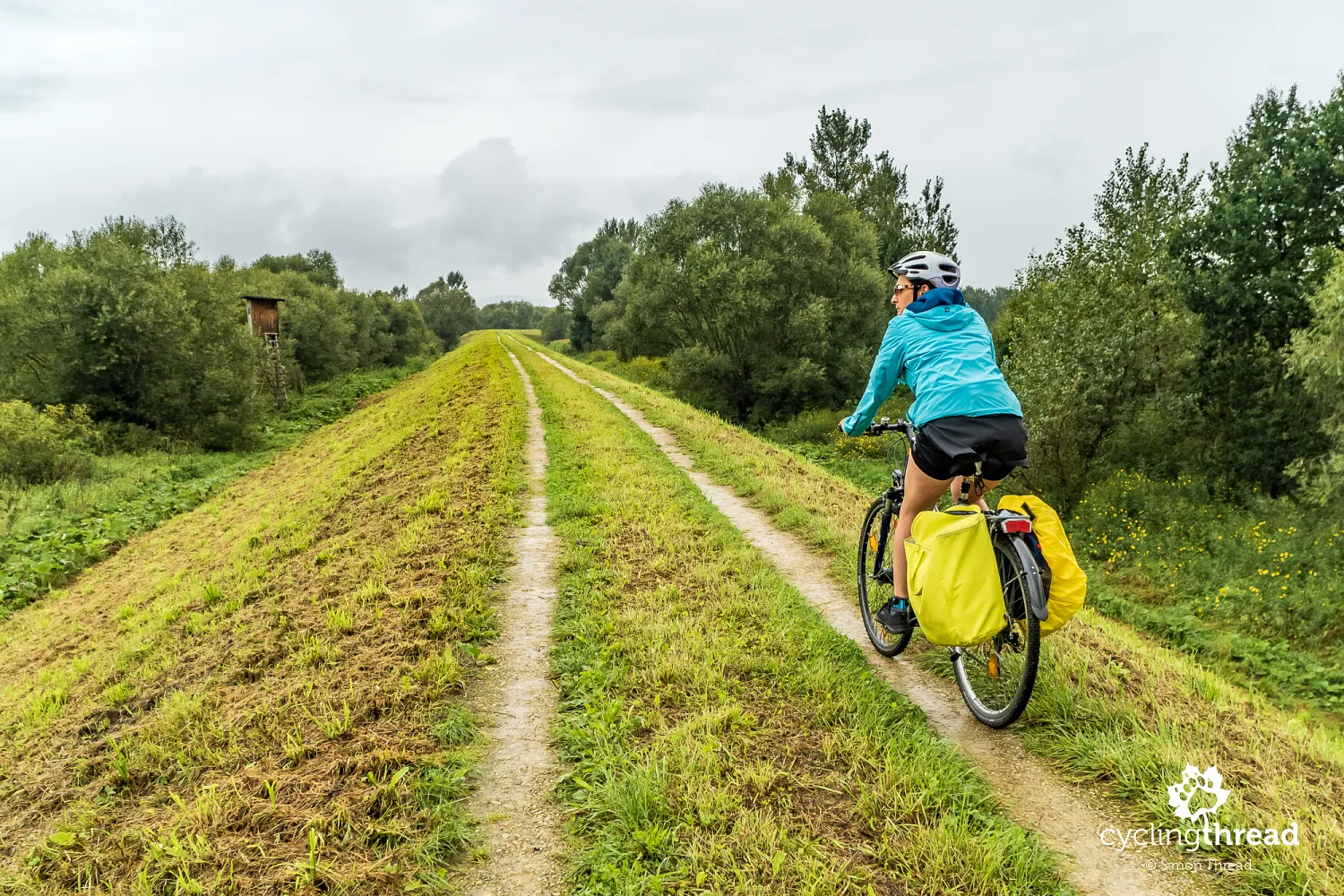
On a Worldtraveller across Malopolska and India
The trip through the Vistula Valley was another adventure where I was accompanied by the ever-traveling worldtraveller from the nearly cult Dutch brand Koga, represented in Poland by the online store Rowery Stylowe. While such a versatile bike isn't necessary for riding on the smooth-as-glass bike paths of the Vistula Cycling Route, it came in handy on some of the off-road segments along the embankments of the Carp Valley. In fact, with a bit of determination, I could also have taken it across the railway sleepers on the bridge over the Vistula in Okleśna... And exactly at the same time, while I am writing down my memories from Malopolska, the same bikes are being ridden through India and Nepal by fellow cycling adventurers - Mateusz Waligóra and Kuba Rybicki. Hard to find a better example of how versatile this design is :)
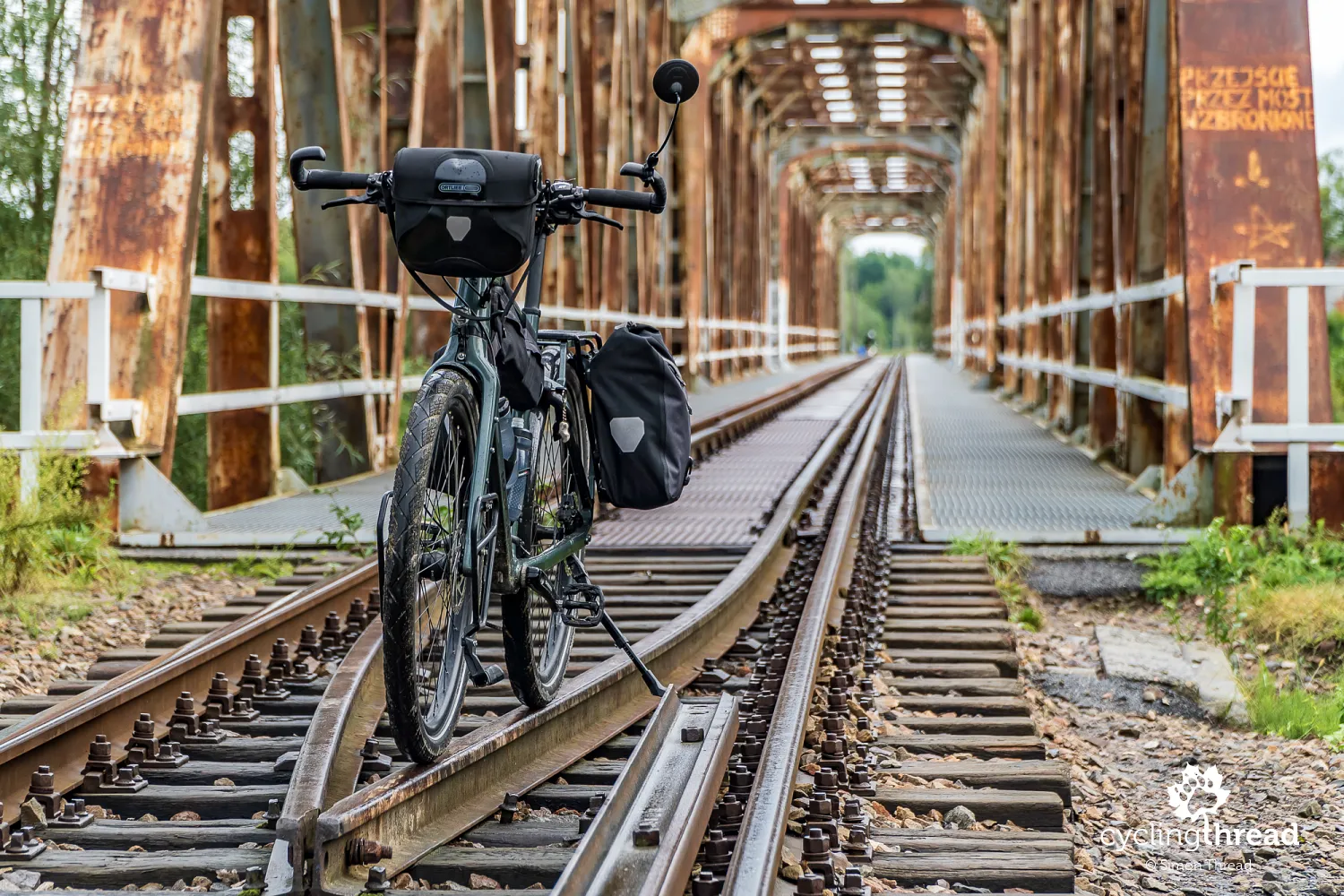
Okleśna bridge is not part of the Vistula Cycling Route
The Okleśna bridge, built in 1899 as part of railway line No. 103 from Trzebinia to Wadowice, and its current shape results from a rebuild in 1946 after being blown up by the Germans. On the other side of the Vistula, you can see the ruins of the original Austrian military watchtower, which was supposed to protect the railway line. Although entering the bridge is strictly prohibited, the line has been unused for many years, and the bridge is equipped with special pedestrian platforms, making a visit there not particularly risky. However, just to be safe, note that you do this at your own risk.
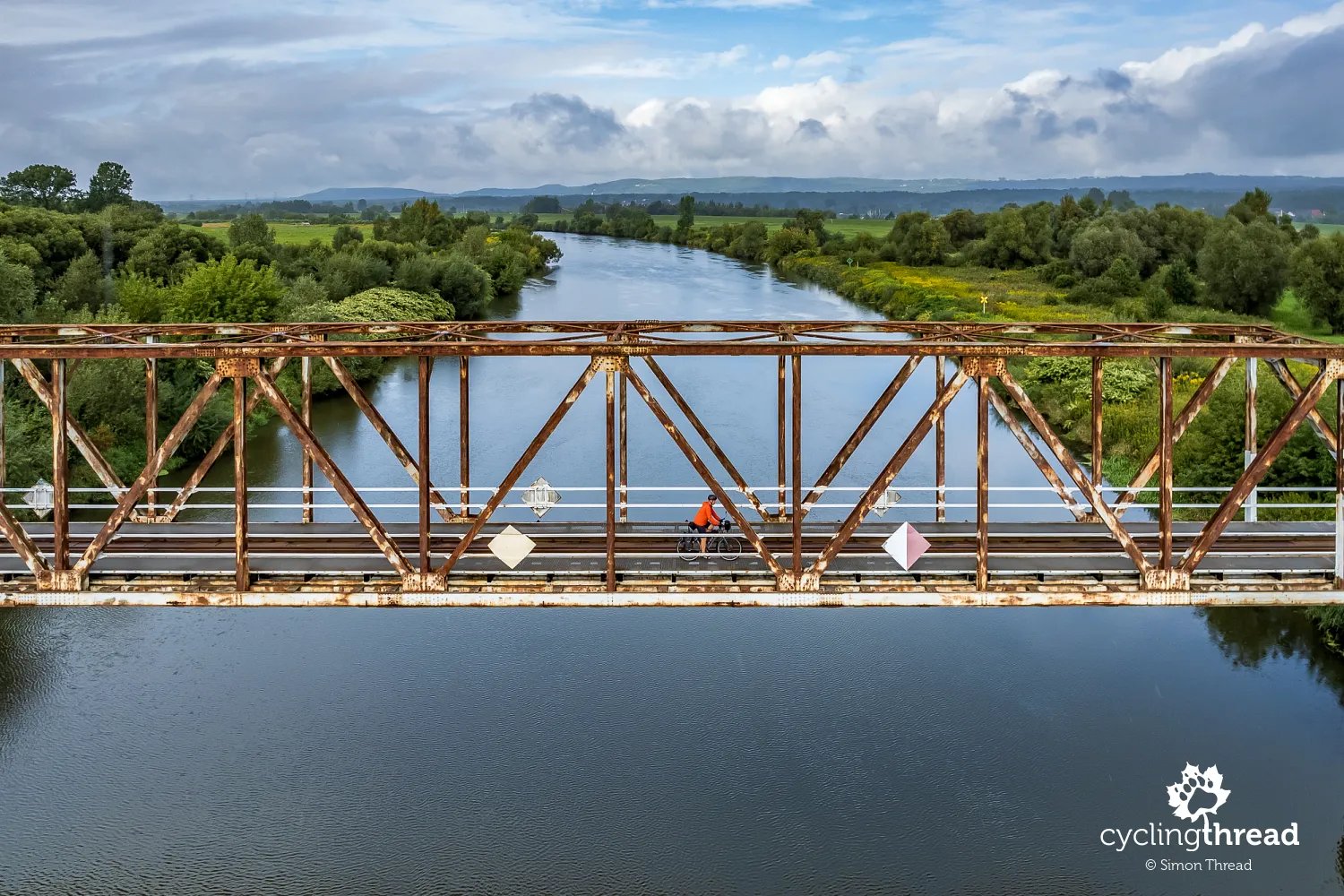
Castles in Babice, Zator and Spytkowice
Returning to the route, Spytkowice quickly appears with the massive form of the currently inaccessible castle. The three-winged Baroque residence with an arcaded courtyard was built in the 17th century on the site of a previous fortress, and its expanded form and splendor are associated with the well-prospering fishponds in the area of Zator and Spytkowice. During the times when the Potocki family owned the Spytkowice estate, the carp bred here was even awarded at the 1900 World's Fair in Paris (the same one for which the Eiffel Tower was built). Today, the castle rooms are used by the National Archives in Kraków, and thus the castle can only be viewed from the outside.
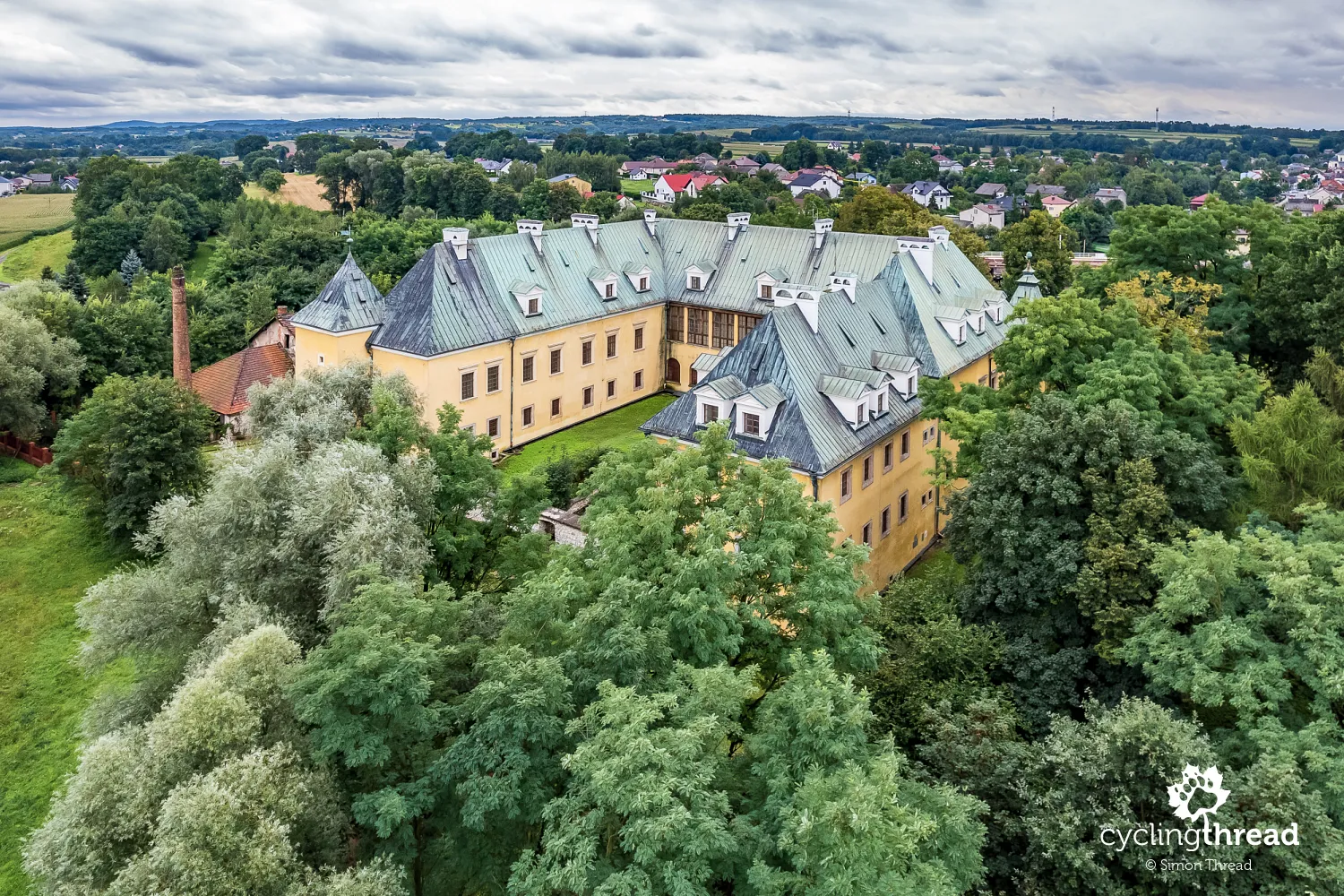
Further kilometers on a cycling journey through Malopolska
The next kilometers of my cycling journey in Malopolska reveal more intriguing local spots. Thanks to the Czernichów-Brzeźnica ferry on the Vistula, I quickly arrive at the Czernichów Station Museum. This small, private railway museum hosts several pieces of various types of railway rolling stock, as well as devices from minor railway infrastructure. However, visiting is somewhat hindered by the fact that the facility is only open on selected Sundays and by prior arrangement. Therefore, I bounce off the closed gate and head back to the road to Brzeźnica, which, after returning to the right bank of the Vistula, passes by several well-preserved wooden cottages and a surprise in the form of a Yak-40 airplane parked on the grounds of one of the local fish farms.
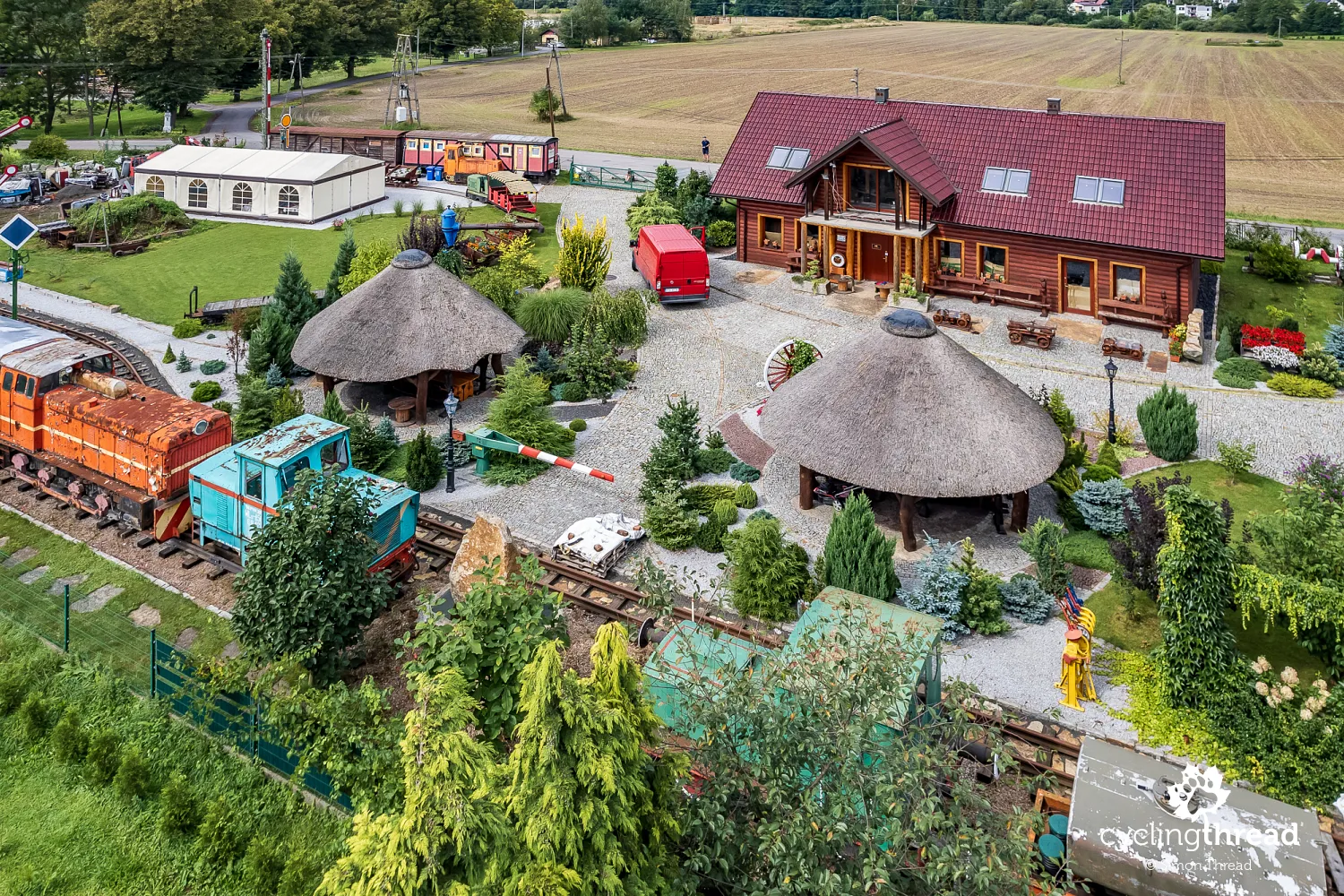
A former granary transformed into a library
I stop in Brzeźnica for two reasons. First, to take a break with a tasty, homemade meal at the recommended, charming restaurant Zachęta, and then to view the impressively renovated granary located in the center of the village. Thanks to a major renovation funded by the European Union, the decaying building in the village center has been transformed into the Spichlerz Książki, serving as the municipal public library. I encourage you to take a look at the photos displayed in the external exhibition to see the transformation the building has undergone. Also, take a peek inside at the interestingly arranged interior successfully serving the local community. You might just meet the friendly librarian who can tell you about the details of this valuable transformation.
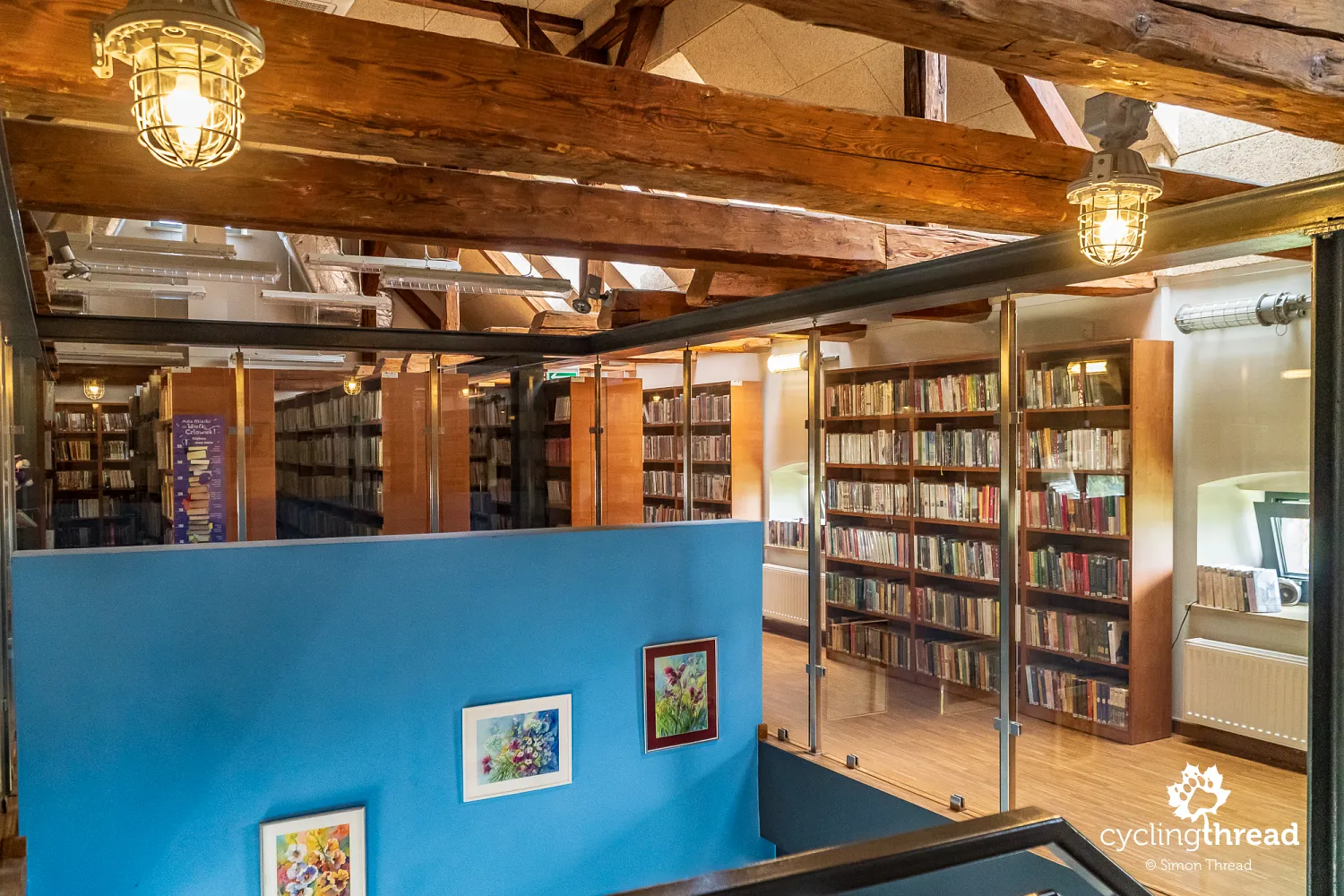
Several kilometers along the Łączany Canal
From Brzeźnica to Skawina, my route runs along the still new investment - a bike path built on the southern bank of the Łączany Canal. This is about 15 kilometers of bike path away from car traffic, which - on the way to Kraków - can replace the Vistula Cycling Route in this area, which runs almost parallel a bit further along, on local roads through Pozowice, Facimiech or Ochodza. Along the Łączany Canal, cycling aficionados might turn up their noses due to the lack of variety in the route and almost zero sum of climbs, but everyone looking for safe and comfortable conditions will surely be satisfied. The canal itself was created in the 1950s, among other reasons, to improve navigation between Silesia and Malopolska by providing an alternative to the highly meandering section of the Vistula at that point.
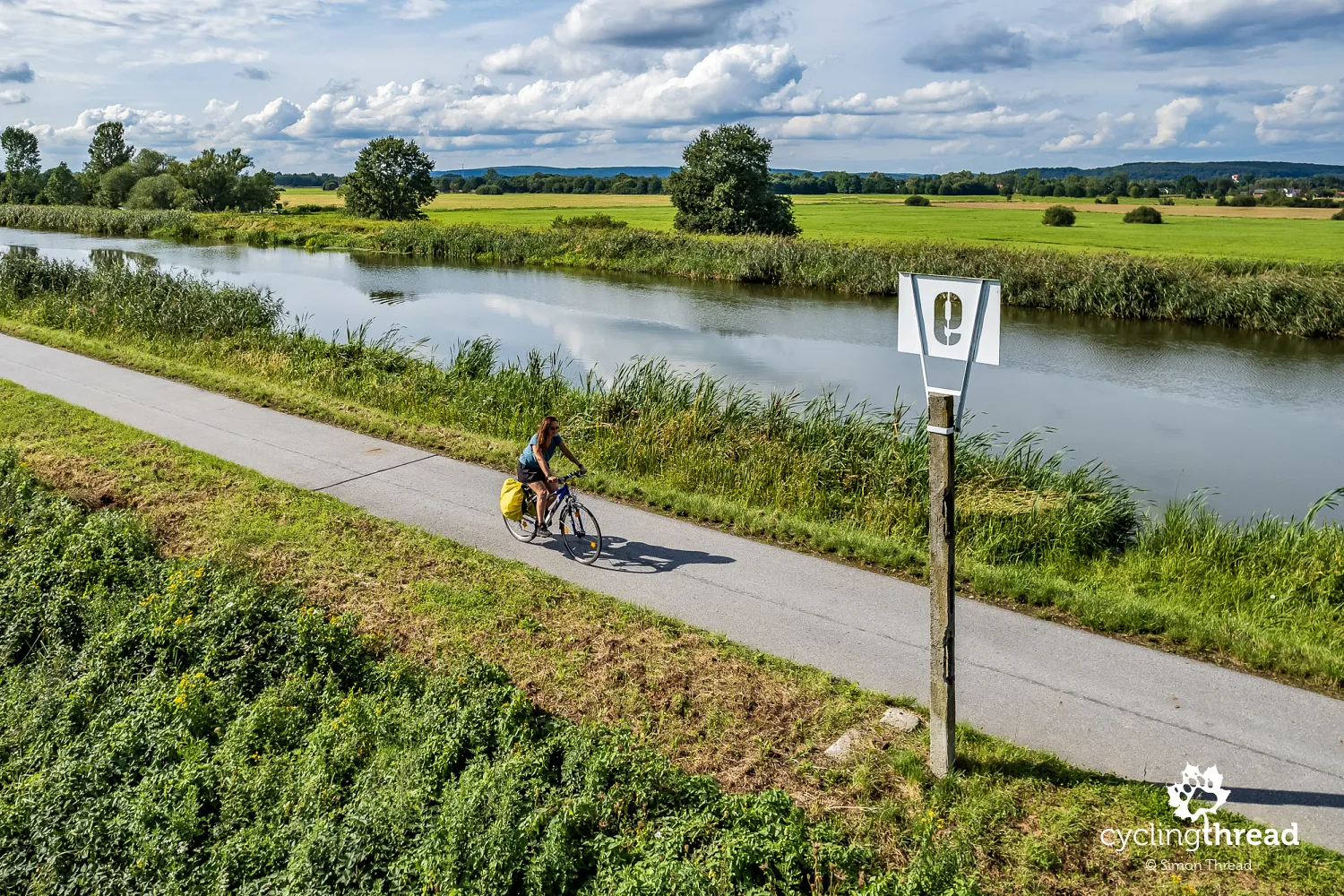
The final kilometers are a quick ride into Kraków. Everything would be at the highest cycling level, if not for Kraków’s “holy holes” along the Vistula Cycling Route. Nothing has changed under the Grodzisko hill since seven years ago, so during bad weather, passing here can be quite challenging or even impossible for parents with child trailers or individuals with limited mobility. Since my first ride here, the Vistula Cycling Route has been enriched with an alternative course along the left bank of the Vistula, among others under the Srebrna Góra vineyard. And riding the traditional right bank, just before reaching Wawel, it's worth briefly detouring right towards the well-known Zakrzówek, where a long-forgotten area of the former quarry has recently been transformed into a modern, friendly urban recreational area.
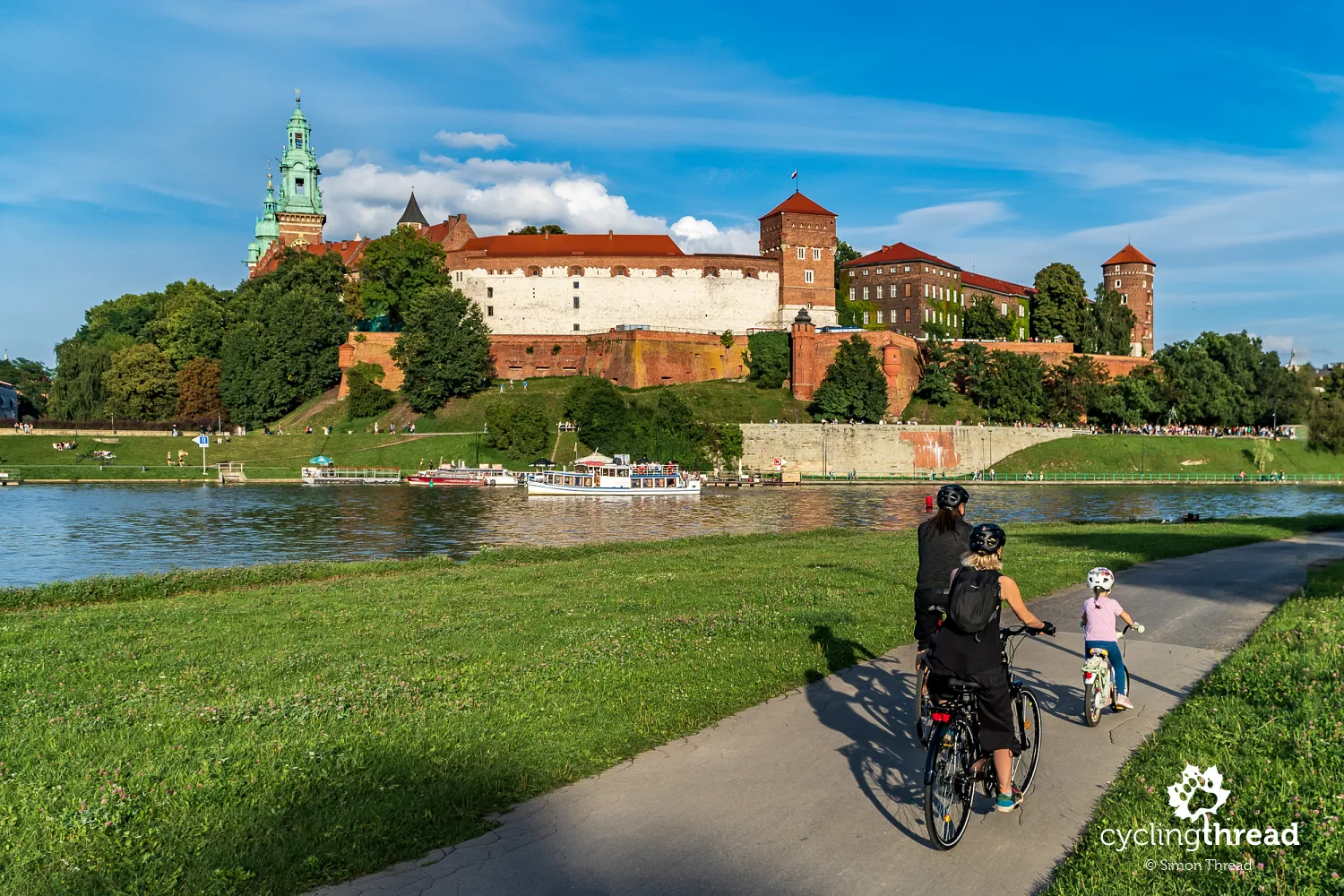
Weekend on the Vistula Cycling Route
The western segment of the Malopolska Vistula Cycling Route is truly a great "base" for recreational and tourist cycling. Whether you travel it in the weekend option I described, the shortest, fastest one-day version, or another variant you devise using the excellent bike paths on the Vistula flood embankments - constantly envy the residents of Malopolska this fantastic initiative, the Velo Małopolska bicycle route network. A must-ride - see you there :-)
Back to top


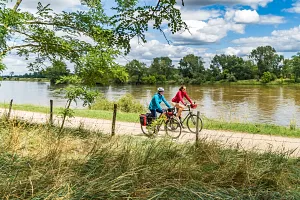
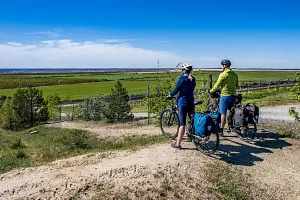
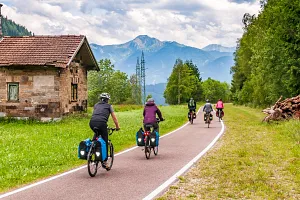
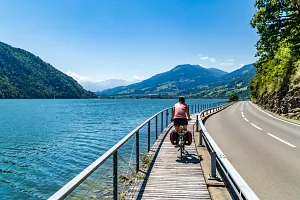
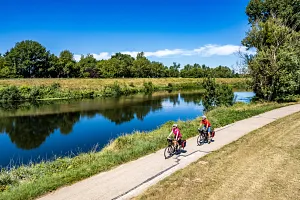
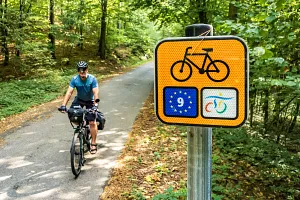
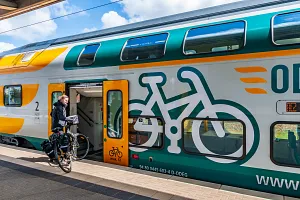
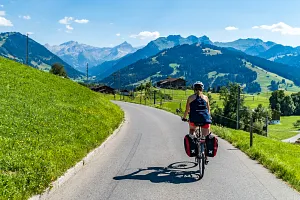
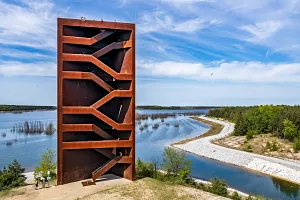
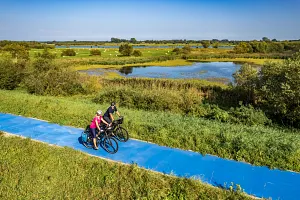
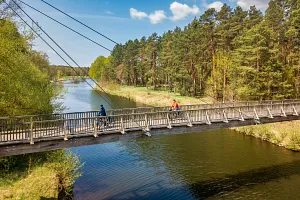
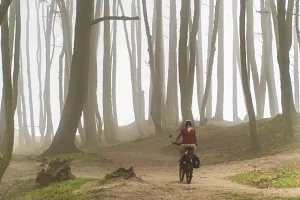

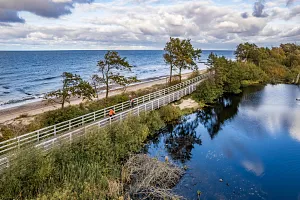
Your Comments
Add new comment